应用框架@SpringBoot
1 Spring Boot 简介
-
简化 Spring 应用开发的一个框架;
-
整个 Spring 技术栈的一个大整合;
-
J2EE 开发的一站式解决方案;
2 微服务
-
微服务:架构风格(服务微化)
-
一个应用应该是一组小型服务,之间可以通过HTTP的方式进行互通;
-
之前:单体应用:ALL IN ONE
-
微服务:每一个功能元素最终都是一个可独立替换和独立升级的软件单元;
3 环境准备
- 环境约束
-
jdk1.8:Spring Boot 推荐jdk1.7及以上;java version "1.8.0_112"
-
maven3.6:maven 3.3以上版本;Apache Maven 3.3.9
-
IntelliJ IDEA2019:
-
SpringBoot 2.2.1.RELEASE;
注:在
spring-boot-dependencies-2.2.1.RELEASE.pom中 可以看到 Tomcat 版本为:9.0.27(L222)
-
(一)MAVEN设置;
给 maven 的 settings.xml 配置文件的 <profiles></profiles>标签添加
<profile>
<id>jdk-1.8</id>
<activation>
<activeByDefault>true</activeByDefault>
<jdk>1.8</jdk>
</activation>
<properties>
<maven.compiler.source>1.8</maven.compiler.source>
<maven.compiler.target>1.8</maven.compiler.target>
<maven.compiler.compilerVersion>1.8</maven.compiler.compilerVersion>
</properties>
</profile>
4 Spring Boot: HelloWorld实现
实现的功能:浏览器发送hello请求,服务器接受请求并处理,响应Hello World字符串;
(一)项目搭建
- 方式一:
- 创建一个maven工程;(jar)
- 导入spring boot相关的依赖(maven.xml)
<parent>
<groupId>org.springframework.boot</groupId>
<artifactId>spring-boot-starter-parent</artifactId>
<version>1.5.9.RELEASE</version>
</parent>
<dependencies>
<dependency>
<groupId>org.springframework.boot</groupId>
<artifactId>spring-boot-starter-web</artifactId>
</dependency>
</dependencies>
- 方式二:File -> New Project -> Spring initializr (选择jdk版本) -> next -> 填写信息(注意修改最后的 package,同时 Artifact 不能有大写字母 ),然后默认 maven 会自动导入相关的依赖。
(二)在主程序中启动Spring Boot应用
package com.gjxaiou;
import org.springframework.boot.SpringApplication;
import org.springframework.boot.autoconfigure.SpringBootApplication;
/**
* @SpringBootApplication 来标注一个主程序类,说明这是一个Spring Boot应用
*/
@SpringBootApplication
public class HelloWorldMainApplication {
public static void main(String[] args) {
// Spring应用启动起来
SpringApplication.run(HelloWorldMainApplication.class,args);
}
}
(三)编写相关的 Controller
package com.gjxaiou.controller;
import org.springframework.stereotype.Controller;
import org.springframework.web.bind.annotation.RequestMapping;
import org.springframework.web.bind.annotation.ResponseBody;
@Controller
public class HelloController {
@ResponseBody
@RequestMapping("/hello")
public String hello(){
return "hello world";
}
}
(四)运行主程序测试
只要直接执行上面的主程序,就可以直接在浏览器中访问:localhost:8080/hello,结果图如下:

(五)简化部署(直接将项目打成 jar,然后在命令行运行即可)
打成 Jar 包
不在需要将项目导出为 war 包然后部署到服务器中,只需要在 maven 中导入下面插件,然后使用右边的 maven Project -> lifecycle -> pageage(右击:run 项目名[package]) 命令就可以直接将项目打成可执行的 jar 包,默认的 jar 包位置在 项目的 target 文件夹下面;可以直接进入该文件夹,然后在文件路径框输入 cmd;
<!-- 这个插件,可以将应用打包成一个可执行的jar包;-->
<build>
<plugins>
<plugin>
<groupId>org.springframework.boot</groupId>
<artifactId>spring-boot-maven-plugin</artifactId>
</plugin>
</plugins>
</build>
运行 Jar 包:将这个应用打成 jar 包之后,直接使用 java -jar 的命令进行执行;java -jar Jar包位置和名称
5 Hello World 原理探究
(一)POM文件
1、父项目
<parent>
<groupId>org.springframework.boot</groupId>
<artifactId>spring-boot-dependencies</artifactId>
<version>2.2.1.RELEASE</version>
</parent>
<!--点击上面之后可以看到他的父项目是:spring-boot-dependencies-2.2.1.RELEASE.pom,下面是部分-->
<parent>
<groupId>org.springframework.boot</groupId>
<artifactId>spring-boot-dependencies</artifactId>
<version>2.2.1.RELEASE</version>
<relativePath>../spring-boot-dependencies</relativePath>
</parent>
<!--打开之后,可以看到下面有属性<properties>,因此他来真正管理Spring Boot应用里面的所有依赖版本_->
上面的就是 Spring Boot 的版本仲裁中心;
以后我们导入依赖默认是不需要写版本;(没有在 dependencies 里面管理的依赖自然需要声明版本号)
2、启动器
<dependency>
<groupId>org.springframework.boot</groupId>
<artifactId>spring-boot-starter-web</artifactId>
</dependency>
-
上面的父项目只是作为版本仲裁,真正的 jar 包导入是由下面这个
spring-boot-starter-web完成的: -
spring-boot-starter:spring-boot 场景启动器,是所有 spring-boot-starter-XXX 的父项目;
-
spring-boot-starter-XXX :作用是:帮我们导入了 XXX(这里是 web) 模块正常运行所依赖的组件;(点击进去就能看见 dependency了)
-
Spring Boot 将所有的功能场景都抽取出来,做成一个个的 starters(启动器),只需要在项目里面引入这些 starter 相关场景,则所有依赖都会导入进来。要用什么功能就导入什么场景的启动器,所有 starter 见官网。
所有 Starter 介绍见官网 1.5. Starters,下面为部分
| Name | Description | Pom |
|---|---|---|
| spring-boot-starter | Core starter, including auto-configuration support, logging and YAML | Pom |
| spring-boot-starter-activemq | Starter for JMS messaging using Apache ActiveMQ | Pom |
| spring-boot-starter-amqp | Starter for using Spring AMQP and Rabbit MQ | Pom |
| spring-boot-starter-aop | Starter for aspect-oriented programming with Spring AOP and AspectJ | Pom |
(二)主程序类,主入口类
/**
* @SpringBootApplication 来标注一个主程序类,说明这是一个Spring Boot应用
*/
@SpringBootApplication
public class HelloWorldMainApplication {
public static void main(String[] args) {
// Spring 应用启动起来
SpringApplication.run(HelloWorldMainApplication.class,args);
}
}
-
@SpringBootApplication: 该注解标注在某个类上说明这个类是 SpringBoot 的主配置类,SpringBoot 就应该运行这个类的 main 方法来启动 SpringBoot 应用;
-
该注解本质上是一个组合注解,由下面一系列注解组成(点击即可查看):
@Target({ElementType.TYPE})
@Retention(RetentionPolicy.RUNTIME)
@Documented
@Inherited
@SpringBootConfiguration
@EnableAutoConfiguration
@ComponentScan(
excludeFilters = {@Filter(
type = FilterType.CUSTOM,
classes = {TypeExcludeFilter.class}
), @Filter(
type = FilterType.CUSTOM,
classes = {AutoConfigurationExcludeFilter.class}
)}
)
public @interface SpringBootApplication {
// 此处省略:XXXXXXX
}
下面分别解释一下上面所有的注解含义:
-
@SpringBootConfiguration:Spring Boot 的配置类;
- 标注在某个类上,表示这是一个 Spring Boot 的配置类;
- 其本质上是 spring 定义的注解(点击内容见下),其中
@Configuration:即使用该注解来标注配置类;
- 其本质上是 spring 定义的注解(点击内容见下),其中
- 标注在某个类上,表示这是一个 Spring Boot 的配置类;
@Target({ElementType.TYPE})
@Retention(RetentionPolicy.RUNTIME)
@Documented
@Configuration
public @interface SpringBootConfiguration {
@AliasFor(
annotation = Configuration.class
)
boolean proxyBeanMethods() default true;
}
- 配置类对应于配置文件;配置类也是容器中的一个组件;@Component
-
@EnableAutoConfiguration:开启自动配置功能;
-
我们需要配置的东西,Spring Boot 帮我们自动配置;使用
@EnableAutoConfiguration告诉 SpringBoot 开启自动配置功能; -
其本质是使用
@AutoConfigurationPackage这个注解进行自动配置(点击);
-
@Target(ElementType.TYPE)
@Retention(RetentionPolicy.RUNTIME)
@Documented
@Inherited
@AutoConfigurationPackage
@Import(AutoConfigurationImportSelector.class)
public @interface EnableAutoConfiguration {
而点击 @AutoConfigurationPackage得到
@Target(ElementType.TYPE)
@Retention(RetentionPolicy.RUNTIME)
@Documented
@Inherited
@Import(AutoConfigurationPackages.Registrar.class)
public @interface AutoConfigurationPackage {
}
- **@Import(AutoConfigurationPackages.Registrar.class)**:
`@Import()`属于 Spring 的底层注解给容器中导入一个组件;导入的组件由`AutoConfigurationPackages.Registrar.class` 类来指定;点击之后在 registrar 类中的 registerBeanDefinitions方法(L122)
static class Registrar implements ImportBeanDefinitionRegistrar, DeterminableImports {
@Override
public void registerBeanDefinitions(AnnotationMetadata metadata, BeanDefinitionRegistry registry) {
register(registry, new PackageImport(metadata).getPackageName());
}
通过 在 register 那行打断点然后 debug 之后,可以看到元数据 metadata 中的 注解(看调试窗口的 Variables 中 的 metadata 的 annotations )是标注在 SPringBootApplication 中的,然后下面的 introspectedClass 可以看出是在 HelloXXXX 上面的,然后选择`new PackageImpot(metadata).getPackageName()`,右击选择`evalate expression`,计算包值得到 `result = com.gjxiaou`
- 因此@**AutoConfigurationPackage**真正的是含义是:将主配置类(用@SpringBootApplication标注的类)的所在包及下面所有子包里面的所有组件扫描到 Spring 容器;
- @**Import**(EnableAutoConfigurationImportSelector.class);
- **EnableAutoConfigurationImportSelector**:导入哪些组件的选择器;
上面方法的父类本质上是将所有需要导入的组件以全类名的方式返回;这些组件就会被添加到容器中;
最终作用是会给容器中导入非常多的自动配置类(xxxAutoConfiguration);自动配置了作用就是给容器中导入这个场景需要的所有组件,并配置好这些组件;
有了自动配置类,免去了我们手动编写配置注入功能组件等的工作;
SpringFactoriesLoader.loadFactoryNames(EnableAutoConfiguration.class,classLoader);
Spring Boot 在启动的时候从类路径下的 META-INF/spring.factories 中获取 EnableAutoConfiguration 指定的值,将这些值作为自动配置类导入到容器中,自动配置类就生效,帮我们进行自动配置工作;以前我们需要自己配置的东西,自动配置类都帮我们;
J2EE的整体整合解决方案和自动配置都在spring-boot-autoconfigure-2.2.1.RELEASE.jar 中;
6 使用Spring Initializer快速创建Spring Boot项目
上面的项目需要创建项目,然后导包并且配置 controller 和启动器,可以使用第四点项目搭建中的方式二实现:
(一)IDEA:使用 Spring Initializer 快速创建项目
默认生成的 Spring Boot 项目特点;
- 主程序已经生成好了,我们只需要完成我们自己的逻辑;
- resources 文件夹中目录结构
- static:保存所有的静态资源,包括 js、css、images;
- templates:保存所有的模板页面;(因为 Spring Boot 默认 jar 包使用嵌入式的 Tomcat,默认不支持JSP 页面);可以使用模板引擎(freemarker、thymeleaf)来支持 JSP;
- application.properties:Spring Boot 应用的配置文件,可以修改一些默认设置;
(二)STS:使用 Spring Starter Project快速创建项目
具体的过程同上
7 配置文件
-
SpringBoot 使用一个全局的配置文件,配置文件名是固定的,位置位于
src/main/resources/下面两者选一即可;-
application.properties(默认创建项目时只有这个)
-
application.yml
-
-
配置文件的作用:修改 SpringBoot 自动配置的默认值;
默认启动是因为 SpringBoot 在底层都给我们自动配置好;
-
YAML(YAML Ain't Markup Language)
-
YAML A Mcomarkup Language:是一个标记语言
-
YAML isn't Markup Language:不是一个标记语言;
-
-
标记语言:
以前的配置文件,大多都使用的是 xxxx.xml 文件;
- YAML:以数据为中心,比json、xml等更适合做配置文件;
YAML:配置例子
server:
port: 8081
对应的 XML 配置:
<server>
<port>8081</port>
</server>
8 YAML语法
(一)基本语法
-
k: v:表示一对键值对(空格必须有),冒号后面都得加空格; -
以空格的缩进来控制层级关系,即只要是左对齐的一列数据,都是同一个层级的;
-
属性和值也是大小写敏感;
server:
port: 8081
path: /hello
(二)值的写法
1.字面量:普通的值(数字,字符串,布尔)
- 使用
k: v:格式直接写字面量即可; - 字符串默认不用加上单引号或者双引号;
'':单引号不会转义字符串里面的特殊字符,特殊字符最终只是一个普通的字符串数据;
name: ‘zhangsan \n lisi’ 输出:zhangsan \n lisi
"":双引号会转义特殊字符,特殊字符会作为本身想表示的意思;
name: "zhangsan \n lisi" 输出:zhangsan 换行 lisi
2.对象、Map(属性和值,即键值对):
k: v:在下一行来写对象的属性和值的关系,注意缩进
friends:
lastName: zhangsan
age: 20
行内写法:
friends: {lastName: zhangsan,age: 18}
3.数组(List、Set):
用 - 值表示数组中的一个元素
pets:
- cat
- dog
- pig
行内写法
pets: [cat,dog,pig]
9 配置文件值注入
1.两种配置文件方式
yml 配置文件:
person:
lastName: 张三
age: 18
birth: 2019/12/15
boss: false
maps: {k1: v1,k2: 14}
lists:
- lisi
- zhaoliu
dog:
name: 小狗
age: 12
上面的 yml 文件对应 properties 文件写法:
# idea.properties配置文件默认是:utf-8
# 配置 person 的值
person.last-name=张三
person.age=18
person.birth=2019/12/15
person.boss=false
person.maps.k1=v1
person.maps.k2=14
person.lists=lisi,zhaoliu
person.dog.name=小狗
person.dog.age=12
2.对应的两种属性注入方式
- 属性值注入方式一:JavaBean:具体的属性值在上面的 yml 配置文件中
// 只有该组件是容器中的组件,才能使用容器提供的@ConfigurationProperties功能,因此要加@Component;
@Component
// @ConfigurationProperties:告诉SpringBoot将本类中的所有属性和配置文件中相关的配置进行绑定,最终作用是:将配置文件中配置的每一个属性的值,映射到这个组件中
// prefix = "person":配置文件中哪个下面的所有属性进行一一映射
@ConfigurationProperties(prefix = "person")
@Getter
@Setter
public class Person {
private String lastName;
private Integer age;
private Boolean boss;
private Date birth;
private Map<String,Object> maps;
private List<Object> lists;
private Dog dog;
}
- 属性值注入方式二:加载 properties 中属性值
取值方式类似于之前 spring 中的配置文件
<bean class="Person">
<property name="lastName" value="字面量,布尔值等等"></property>
<bean/>
可以使用 ${key} 从环境变量、配置文件中获取值,或者 #{SpEL} 使用表达式
package com.gjxaiou.springboot.bean;
@Component
public class Person {
@Value("${person.last-name}")
private String lastName;
@Value("#{11*2}")
private Integer age;
@Value("true")
private Boolean boss;
private Date birth;
@Value("${person.maps}")
private Map<String,Object> maps;
private List<Object> lists;
private Dog dog;
附:Dog Bean:
@Getter
@Setter
public class Dog {
private String name;
private Integer age;
}
附:我们可以导入配置文件处理器(pom.xml),以后编写配置(配置文件进行绑定)就有提示了
<!--导入配置文件处理器,配置文件进行绑定就会有提示-->
<dependency>
<groupId>org.springframework.boot</groupId>
<artifactId>spring-boot-configuration-processor</artifactId>
<optional>true</optional>
</dependency>
3.测试
测试类的值是否导入:
package com.gjxaiou.springboot;
/**
* SpringBoot单元测试;
* 可以在测试期间很方便的类似编码一样进行自动注入等容器的功能
*/
@RunWith(SpringRunner.class)
@SpringBootTest
public class SpringBoot02ConfigApplicationTests {
@Autowired
Person person;
@Autowired
ApplicationContext ioc;
@Test
public void testHelloService(){
boolean b = ioc.containsBean("helloService02");
System.out.println(b);
}
@Test
public void contextLoads() {
System.out.println(person);
}
}
10 配置文件说明
(一)@Value 获取值和 @ConfigurationProperties 获取值比较
| @ConfigurationProperties(YAML 形式) | @Value(配置文件形式) | |
|---|---|---|
| 功能 | 批量注入配置文件中的属性 | 需要一个个指定 |
| 松散绑定(松散语法) | 支持(见下面说明) | 不支持 |
| SpEL(例如 # {表达式}) | 不支持 | 支持 |
| JSR303数据校验 | 支持 | 不支持 |
| 复杂类型封装(例如 map 类型) | 支持 | 不支持 |
配置文件 yml 还是 properties 他们都能获取到值;
-
如果只是在某个业务逻辑中需要获取一下配置文件中的某项值,使用
@Value; -
如果专门编写了一个 JavaBean 来和配置文件进行映射,我们就直接使用
@ConfigurationProperties;
上面名词解释
- 松散绑定:就是代码中的变量名和 yml 文件中的变量名的对应绑定
以 person.firstName 变量为例,对应的 yml 文件中可以为:person.firstName person.first-name person.first_name PERSON_FIRSTNAME都可以,其中 - 和 _ 都表示大写。
- 数据校验:类上面需要增加:
@Validated注解,同时需要校验的变量名上面加上对应想校验的格式;示例如下:
@Component
@ConfigurationProperties(prefix = "person")
@Validated
public class Person {
// 表示要校验 lastName 的值是否为邮箱格式
@Email
private String lastName;
(二)@PropertySource & @ImportResource & @Bean
-
@PropertySource:作用是加载指定的配置文件;
因为上面的
@ConfigurationProperties(prefix = "person")默认从全局配置文件中获取值;如果这两个命令都写并且默认的配置文件和person.properties中都有属性值,则加载全局配置文件中的值;
@PropertySource(value = {"classpath:person.properties"})
@Component
public class Person {
private String lastName;
private Integer age;
private Boolean boss;
对应的 person.properties 文件
person.last-name=李四
person.age=12
person.birth=2017/12/15
person.boss=false
person.maps.k1=v1
person.maps.k2=14
person.lists=a,b,c
person.dog.name=dog
person.dog.age=15
-
@ImportResource:导入 Spring 的配置文件,让配置文件里面的内容生效;
首先可以创建一个 service 类:HelloService.java;
然后创建一个 spring的 xml 配置文件 bean.xml,配置如下:
<?xml version="1.0" encoding="UTF-8"?>
<beans xmlns="http://www.springframework.org/schema/beans"
xmlns:xsi="http://www.w3.org/2001/XMLSchema-instance"
xsi:schemaLocation="http://www.springframework.org/schema/beans http://www.springframework.org/schema/beans/spring-beans.xsd">
<bean id="helloService" class="com.gjxaiou.springboot.service.HelloService"></bean>
</beans>
Spring Boot 里面没有 Spring 的配置文件,而我们自己编写的配置文件(bean.xml),也不能自动识别,因此想让 Spring 的配置文件生效,加载进来;就使用 @ImportResource标注在一个配置类上(这里的注解是标注在主配置类:SpringBootConfigApplication.java 上)
// 导入Spring的配置文件让其生效
@ImportResource(locations = {"classpath:beans.xml"})
然后在测试类中:可以验证该类是否在 IOC 容器中
package com.gjxaiou.springboot;
@RunWith(SpringRunner.class)
@SpringBootTest
public class SpringBoot02ConfigApplicationTests {
@Autowired
ApplicationContext ioc;
@Test
public void testHelloService(){
boolean b = ioc.containsBean("helloService");
System.out.println(b);
}
}
结果为 true.
- @Bean
@Bean 是 SpringBoot 推荐的给容器中添加组件的方式:推荐使用全注解的方式,就是使用配置类代替 xml 配置文件中的 <bean></bean>
首先要写个配置类,同时加上 @Configuration------>类似于上面的 Spring 配置文件
使用 @Bean 给容器中添加组件
/**
* @Configuration:指明当前类是一个配置类;就是来替代之前的 Spring 配置文件
* 之前在配置文件中用 <bean><bean/>标签添加组件,这里使用 @Bean 注解
*
*/
@Configuration
public class MyAppConfig {
//作用:将方法的返回值添加到容器中;容器中这个组件默认的id就是方法名
@Bean
public HelloService helloService(){
System.out.println("配置类@Bean给容器中添加组件了...");
return new HelloService();
}
}
(三)配置文件占位符
1、随机数
${random.value}、${random.int}、${random.long}
${random.int(10)}、${random.int[1024,65536]}
2、占位符获取之前配置的值,如果没有可以是用: 指定默认值
这里的属性值是配置在默认的 application.properties 中,配置在其他之后就是需要在下面的 Java 代码中添加以下位置即可;
person.last-name=张三${random.uuid}
person.age=${random.int}
person.birth=2017/12/15
person.boss=false
person.maps.k1=v1
person.maps.k2=14
person.lists=a,b,c
# 因为这里没有 person.hello ,因此使用 ${person.hello},最终结果显示就是:${person.hello},这里的 : 表示如果没有值,就赋值 hello1 作为默认值
person.dog.name=${person.hello:hello1}_dog
#person.dog.name=${person.last-name}
person.dog.age=15
对应的Person 类配置和上面代码一样:
然后测试类为:
package com.gjxaiou.springboot;
import com.gjxaiou.springboot.bean.Person;
import org.junit.Test;
import org.junit.runner.RunWith;
import org.springframework.beans.factory.annotation.Autowired;
import org.springframework.boot.test.context.SpringBootTest;
import org.springframework.context.ApplicationContext;
import org.springframework.test.context.junit4.SpringRunner;
/**
* SpringBoot单元测试;
* 可以在测试期间很方便的类似编码一样进行自动注入等容器的功能
*/
@RunWith(SpringRunner.class)
@SpringBootTest
public class SpringBoot02ConfigApplicationTests {
@Autowired
Person person;
@Test
public void contextLoads() {
System.out.println(person);
}
}
(四)Profile,是 spring 用于多环境支持的
就是测试、开发等等的配置文件是不相同的,方便进行切换
- 方式一:多 Profile 文件
我们在主配置文件编写的时候,文件名可以是 application-{profile}.properties/yml
例如配置文件为:application-dev.properties/application-product.properties/application.properties
默认使用application.properties的配置;如果想使用使其配置文件,需要在 application.properties 中输入:spring.profiles.active=dev 就激活使用 application-dev.properties 配置文件;
- 方式二:yml 支持多文档块方式
下面都是在 application.yml 中配置,使用 --- 分割成不同的文档块;最上面是默认的,如果想激活其他的,只要在最上面的 里面添加 :active即可
server:
port: 8081
spring:
profiles:
active: prod
---
server:
port: 8083
spring:
profiles: dev
---
server:
port: 8084
spring:
profiles: prod #指定属于哪个环境
附:激活指定 profile 方式
-
(针对方式一)在配置文件中指定
spring.profiles.active=dev(针对 properties 文件) -
命令行(针对方式一、二):IDEA 中 Run/Debug Configurations 中添加的 SpringBoot 右边对应的:
program arguments中输入下面语句--spring.profiles.active=dev,如果打包之后运行可以使用:java -jar spring-boot-02-config-0.0.1-SNAPSHOT.jar --spring.profiles.active=dev指定
即可以直接在测试的时候,配置传入命令行参数;
- 虚拟机参数(针对方式一、二):IDEA上面配置中的:
VM options中配置:-Dspring.profiles.active=dev

11 内部配置文件加载位置
SpringBoot 启动会按照顺序扫描以下位置的 application.properties 或者 application.yml 文件作为 SpringBoot的默认配置文件:file 表示当前项目的文件夹,classpath:表示类路径,就是 resources 目录下
–file:./config/
–file:./
–classpath:/config/
–classpath:/
以上优先级由高到底,高优先级的配置会覆盖低优先级的配置,同时 SpringBoot 会从这四个位置全部加载主配置文件,互补配置;
-
我们还可以通过
spring.config.location属性来改变默认的配置文件位置项目打包好以后,我们可以使用命令行参数的形式,启动项目的时候来指定配置文件的新位置;指定配置文件和默认加载的这些配置文件共同起作用形成互补配置;
命令为:java -jar spring-boot-02-config-02-0.0.1-SNAPSHOT.jar --spring.config.location=D:/application.properties
12 外部配置加载顺序
SpringBoot也可以从以下位置加载配置; 优先级从高到低;高优先级的配置覆盖低优先级的配置,所有的配置会形成互补配置
-
命令行参数
因为项目在打包的时候,只会将 main 包下面的 java 和 resources 中的内容进行打包,因此像上面直接在项目根目录下面配置的配置文件是不会被打包的;
所有的配置都可以在命令行上进行指定(也是互补方式),只要多个配置用空格分开,格式均为
--配置项=值,一般适用于小部分的值。示例:
java -jar spring-boot-02-config-02-0.0.1-SNAPSHOT.jar --server.port=8087 --server.context-path=/abc
-
来自 java:comp/env 的 JNDI 属性
-
Java 系统属性(System.getProperties())
-
操作系统环境变量
-
RandomValuePropertySource 配置的 random.* 属性值
由jar包外向jar包内进行寻找;同时优先加载带 profile,然后加载不带 profile
-
jar包外部设置的的application-{profile}.properties或application.yml(带spring.profile)配置文件(相当于已经将项目打包之后,然后新建一个配置文件放在 jar 包同文件夹下面)
-
jar包内部的application-{profile}.properties或application.yml(带spring.profile)配置文件
-
jar包外部的application.properties或application.yml(不带spring.profile)配置文件
-
jar包内部的application.properties或application.yml(不带spring.profile)配置文件
-
@Configuration注解类上的@PropertySource -
通过
SpringApplication.setDefaultProperties指定的默认属性
所有支持的配置加载来源参考官方文档
13 自动配置原理
配置文件到底能写什么?怎么写?自动配置原理;
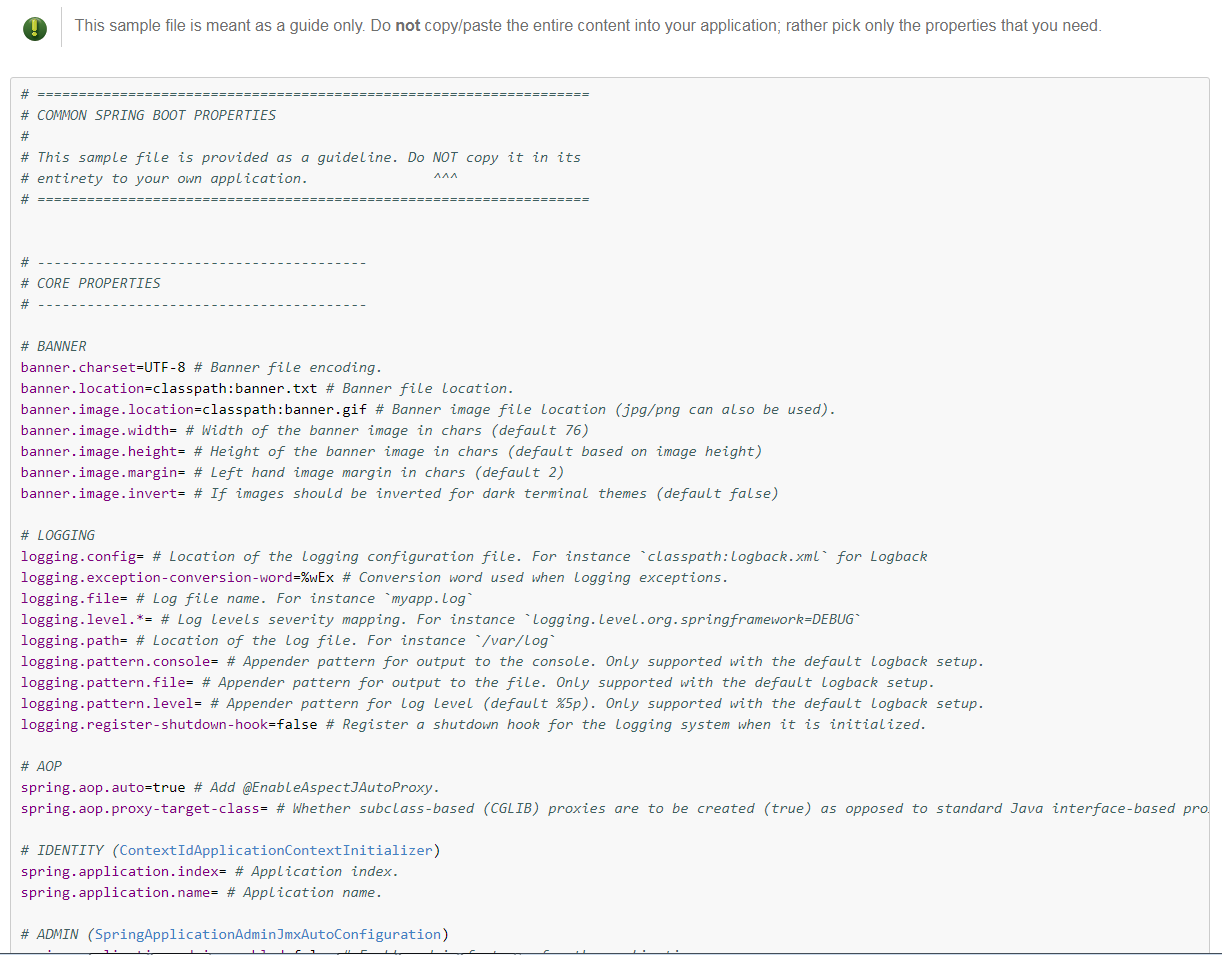
(一)自动配置原理
-
SpringBoot 启动的时候加载主配置类,然后加载主配置类上面的
@SpringBootApplication,该注解(点进去),最主要作用就是开启了自动配置功能 @EnableAutoConfiguration; -
@EnableAutoConfiguration 作用:(点进去)
-
利用 @Import 中的
EnableAutoConfigurationImportSelector选择器给容器中导入一些组件; -
点进去然后查看其父类
AutoConfigurationImportSelector中的selectImports()方法的内容,就知道导入哪些内容了; -
上面那个
selectImports()方法最终返回
-
List<String> configurations = getCandidateConfigurations(annotationMetadata, attributes);
获取候选的配置,getCandidateConfiguration 类中最重要的是:SpringFactoriesLoader.loadFactoryNames() 方法(代码见下),
protected List<String> getCandidateConfigurations(AnnotationMetadata metadata, AnnotationAttributes attributes) {
List<String> configurations = SpringFactoriesLoader.loadFactoryNames(this.getSpringFactoriesLoaderFactoryClass(), this.getBeanClassLoader());
Assert.notEmpty(configurations, "No auto configuration classes found in META-INF/spring.factories. If you are using a custom packaging, make sure that file is correct.");
return configurations;
}
该方法作用(点进去)是从类路径下面得到资源,得到的资源是:扫描所有 jar 包类路径下 META-INF/spring.factories 文件(这部分是 loadFactoryNames() 中调用的 loadSpringFactories() 方法里面)然后扫描文件的 URL 把扫描到的这些文件的内容包装成 properties 对象,从properties中获取到 EnableAutoConfiguration.class 类(类名)对应的值,然后把他们添加在容器中。
下面为 LoadFactoryNames() 方法的具体代码
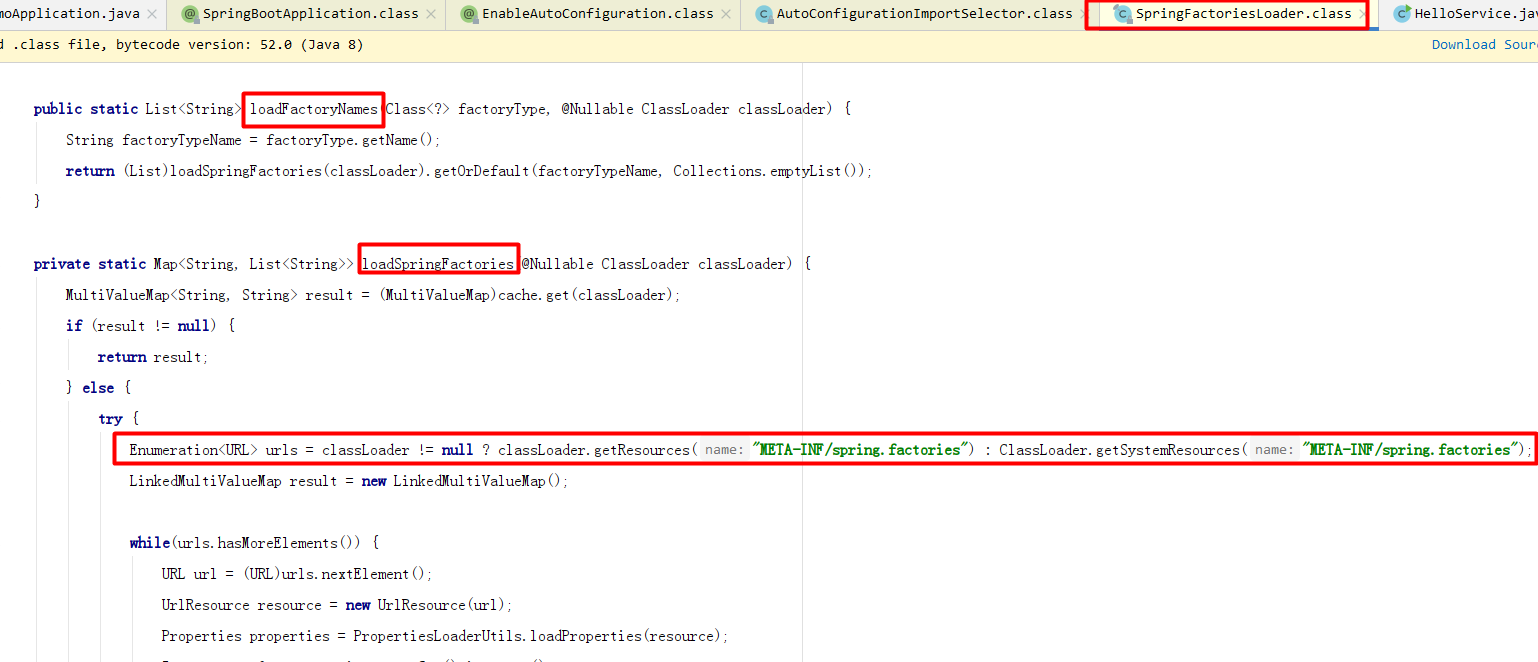
public static List<String> loadFactoryNames(Class<?> factoryType, @Nullable ClassLoader classLoader) {
String factoryTypeName = factoryType.getName();
return (List)loadSpringFactories(classLoader).getOrDefault(factoryTypeName, Collections.emptyList());
}
private static Map<String, List<String>> loadSpringFactories(@Nullable ClassLoader classLoader) {
MultiValueMap<String, String> result = (MultiValueMap)cache.get(classLoader);
if (result != null) {
return result;
} else {
try {
// 扫描所有 jar 包类路径下面的 META-INF/spring.factories 文件
Enumeration<URL> urls = classLoader != null ? classLoader.getResources("META-INF/spring.factories") : ClassLoader.getSystemResources("META-INF/spring.factories");
LinkedMultiValueMap result = new LinkedMultiValueMap();
// 然后扫描文件的 URL 把扫描到的这些文件的内容包装成 properties 对象
while(urls.hasMoreElements()) {
URL url = (URL)urls.nextElement();
UrlResource resource = new UrlResource(url);
Properties properties = PropertiesLoaderUtils.loadProperties(resource);
Iterator var6 = properties.entrySet().iterator();
while(var6.hasNext()) {
Entry<?, ?> entry = (Entry)var6.next();
String factoryTypeName = ((String)entry.getKey()).trim();
String[] var9 = StringUtils.commaDelimitedListToStringArray((String)entry.getValue());
int var10 = var9.length;
for(int var11 = 0; var11 < var10; ++var11) {
String factoryImplementationName = var9[var11];
result.add(factoryTypeName, factoryImplementationName.trim());
}
}
}
cache.put(classLoader, result);
return result;
} catch (IOException var13) {
throw new IllegalArgumentException("Unable to load factories from location [META-INF/spring.factories]", var13);
}
}
}
因此其作用是:将类路径下 META-INF/spring.factories 里面配置的所有 EnableAutoConfiguration的值添加到容器中;容器中会有以下类(在下面文件中):
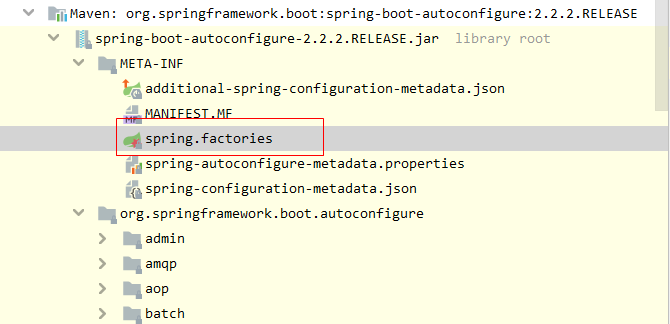
# Auto Configure
org.springframework.boot.autoconfigure.EnableAutoConfiguration=\
org.springframework.boot.autoconfigure.admin.SpringApplicationAdminJmxAutoConfiguration,\
org.springframework.boot.autoconfigure.aop.AopAutoConfiguration,\
org.springframework.boot.autoconfigure.amqp.RabbitAutoConfiguration,\
org.springframework.boot.autoconfigure.batch.BatchAutoConfiguration,\
org.springframework.boot.autoconfigure.cache.CacheAutoConfiguration,\
...
org.springframework.boot.autoconfigure.websocket.WebSocketAutoConfiguration,\
org.springframework.boot.autoconfigure.websocket.WebSocketMessagingAutoConfiguration,\
org.springframework.boot.autoconfigure.webservices.WebServicesAutoConfiguration
每一个这样的 xxxAutoConfiguration类都是容器中的一个组件,都加入到容器中;用他们来做自动配置;
- 每一个自动配置类进行自动配置功能
以HttpEncodingAutoConfiguration(Http编码自动配置)为例解释自动配置原理;下面就是该类的具体内容
// 表示这是一个配置类,和以前编写的配置文件一样,也可以给容器中添加组件
@Configuration
// 启动指定类(括号中的类,点击这个类就发现该类上面标注了 @configurationProperties 注解,类的内容见下一个代码块)的 ConfigurationProperties 功能;将配置文件中对应的值和 HttpEncodingProperties 绑定起来;并把 HttpEncodingProperties 加入到 ioc 容器中
@EnableConfigurationProperties(HttpEncodingProperties.class)
// 底层是:Spring 的 @Conditional 注解,作用是:根据不同的条件,如果满足指定的条件,整个配置类里面的配置才会生效; 这里作用是:判断当前应用是否是web应用,如果是,当前配置类生效
@ConditionalOnWebApplication
// 判断当前项目有没有这个类(CharacterEncodingFilter);该类是 SpringMVC 中进行乱码解决的过滤器;
@ConditionalOnClass(CharacterEncodingFilter.class)
// 判断配置文件中是否存在某个配置,这里就是:spring.http.encoding.enabled;后面的 matchIfMissing 表示如果不存在,判断也是成立的,即即使我们配置文件中不配置pring.http.encoding.enabled=true,也是默认生效的;
@ConditionalOnProperty(prefix = "spring.http.encoding", value = "enabled", matchIfMissing = true)
public class HttpEncodingAutoConfiguration {
// 它已经和 SpringBoot 的配置文件映射了,它是获取配置文件中的值的
private final HttpEncodingProperties properties;
// 只有一个有参构造器的情况下,参数的值就会从容器中拿,使用上面的 @EnableConfigurationProperties 注解将括号中的类加入 IOC 容器中
public HttpEncodingAutoConfiguration(HttpEncodingProperties properties) {
this.properties = properties;
}
@Bean // @Bean 表示给容器中添加一个组件(这里对应的组件就是 CharacterEncodingFilter),这个组件的某些值需要从 properties 中获取
@ConditionalOnMissingBean(CharacterEncodingFilter.class) //判断容器没有这个组件?
public CharacterEncodingFilter characterEncodingFilter() {
CharacterEncodingFilter filter = new OrderedCharacterEncodingFilter();
filter.setEncoding(this.properties.getCharset().name());
filter.setForceRequestEncoding(this.properties.shouldForce(Type.REQUEST));
filter.setForceResponseEncoding(this.properties.shouldForce(Type.RESPONSE));
return filter;
}
上面整个配置类作用就是:根据当前不同的条件判断,决定这个配置类是否生效
一但这个配置类生效;这个配置类就会给容器中添加各种组件;这些组件的属性是从对应的 properties 类中获取的,这些类里面的每一个属性又是和配置文件绑定的;
- 所有在配置文件中能配置的属性都是在 xxxxProperties 类中封装着;例如配置文件(spring.http.encoding)能配置什么就可以参照某个功能对应的这个属性类(HttpEncodingProperties)
@ConfigurationProperties(prefix = "spring.http.encoding") //从配置文件中获取指定的值和bean的属性进行绑定
public class HttpEncodingProperties {
public static final Charset DEFAULT_CHARSET = Charset.forName("UTF-8");
-
精髓:
- SpringBoot 启动会加载大量的自动配置类;
- 看我们需要的功能有没有 SpringBoot 默认写好的自动配置类;
- 如果有,我们再来看这个自动配置类中到底配置了哪些组件;(只要我们要用的组件有,我们就不需要再来配置了)
- 给容器中自动配置类添加组件的时候,会从 properties 类中获取某些属性。我们就可以在配置文件中指定这些属性的值;
-
xxxxAutoConfigurartion:自动配置类;作用是给容器中添加组件,同时也会有对应的 xxxxProperties 封装配置文件中相关属性;
示例解释
使用 Ctrl + n 查找:*AutoConfiguration,这里以 CacheAutoconfiguration 为例,有相应的属性自动配置类:``CacheAutoconfiguration.java对应就有相应的属性值的获取:见上面的 @EnableConfigurationProperties 中的括号中类,即 CacheProperties.class,点击之后就可以看出来可以配置哪些属性,属性前缀就是上面的注解@ConfigurationProperties中的内容,后面更上该类的变量名:例如可以在 properties 文件中配置:spring.cache.type`
(二)细节
1、@Conditional 派生注解
作用:必须是 @Conditional 指定的条件成立,才给容器中添加组件,配置配里面的所有内容才生效;
还是以上面 HttpEncodingAutoConfiguration 代码为例
@Configuration
@EnableConfigurationProperties(HttpEncodingProperties.class)
// 这里就是三个 Condition 注解判断,只有他们都成立了配置才生效;
// @ConditionOnXX 本质上(点击)就是使用 Spring 的 @condition 注解,@Condition(指定的条件判断类,点击该类,发现该类有一个 match 方法,通过一系列的判断,最终返回 true/false)
@ConditionalOnWebApplication
@ConditionalOnClass(CharacterEncodingFilter.class)
@ConditionalOnProperty(prefix = "spring.http.encoding", value = "enabled", matchIfMissing = true)
public class HttpEncodingAutoConfiguration {
private final HttpEncodingProperties properties;
public HttpEncodingAutoConfiguration(HttpEncodingProperties properties) {
this.properties = properties;
}
// 同样这里注入的时候,进行了Condition的判断
@Bean
@ConditionalOnMissingBean(CharacterEncodingFilter.class) //判断容器没有这个组件?
public CharacterEncodingFilter characterEncodingFilter() {
CharacterEncodingFilter filter = new OrderedCharacterEncodingFilter();
filter.setEncoding(this.properties.getCharset().name());
filter.setForceRequestEncoding(this.properties.shouldForce(Type.REQUEST));
filter.setForceResponseEncoding(this.properties.shouldForce(Type.RESPONSE));
return filter;
}
spring boot 将 @condition 注解扩展了
| @Conditional扩展注解 | 作用(判断是否满足当前指定条件) |
|---|---|
| @ConditionalOnJava | 系统的java版本是否符合要求 |
| @ConditionalOnBean | 容器中存在指定Bean; |
| @ConditionalOnMissingBean | 容器中不存在指定Bean; |
| @ConditionalOnExpression | 满足SpEL表达式指定 |
| @ConditionalOnClass | 系统中有指定的类 |
| @ConditionalOnMissingClass | 系统中没有指定的类 |
| @ConditionalOnSingleCandidate | 容器中只有一个指定的Bean,或者这个Bean是首选Bean |
| @ConditionalOnProperty | 系统中指定的属性是否有指定的值 |
| @ConditionalOnResource | 类路径下是否存在指定资源文件 |
| @ConditionalOnWebApplication | 当前是web环境 |
| @ConditionalOnNotWebApplication | 当前不是web环境 |
| @ConditionalOnJndi | JNDI存在指定项 |
自动配置类必须在一定的条件下才能生效;条件就是上面的一系列 @condition 判断
我们怎么知道哪些自动配置类生效;所有的自动配置类都在 jar 包:spring-boot-autoconfigure 下的 spring.factories,点开每一个配置类都可以看出该控制类有没有生效(因为每个控制类都需要一定的condition,如果里面有冒红就是不生效),但是挨个点击判断太过于麻烦,
我们可以在配置文件 application.properties 通过启用 debug=true 属性,开启 spring boot 的 debug 模式,来让控制台打印自动配置报告,这样我们就可以很方便的知道哪些自动配置类生效,下面是输出示例:
Positive matches:(自动配置类启用的)
-----------------
DispatcherServletAutoConfiguration matched:
- @ConditionalOnClass found required class 'org.springframework.web.servlet.DispatcherServlet'; @ConditionalOnMissingClass did not find unwanted class (OnClassCondition)
- @ConditionalOnWebApplication (required) found StandardServletEnvironment (OnWebApplicationCondition)
Negative matches:(没有启动,没有匹配成功的自动配置类)
-----------------
ActiveMQAutoConfiguration:
Did not match:
- @ConditionalOnClass did not find required classes 'javax.jms.ConnectionFactory', 'org.apache.activemq.ActiveMQConnectionFactory' (OnClassCondition)
AopAutoConfiguration:
Did not match:
- @ConditionalOnClass did not find required classes 'org.aspectj.lang.annotation.Aspect', 'org.aspectj.lang.reflect.Advice' (OnClassCondition)
..................................
14 日志框架
(一)常见日志框架
JUL、JCL、Jboss-logging、logback、log4j、log4j2、slf4j....
(二)日志分类
- 日志门面(日志的抽象层)
JCL(Jakarta Commons Logging)- SLF4j(Simple Logging Facade for Java)
jboss-logging
- 日志的实现
- Log4j
- JUL(java.util.logging)
- Log4j2
- Logback
一般选一个门面(抽象层)同时选一个实现;
SpringBoot:底层是 Spring 框架,Spring 框架默认是用 JCL;SpringBoot 选用 SLF4j 和 logback;
15 SLF4j使用
(一)如何在系统中使用SLF4j
开发的时候,日志记录方法的调用,不应该来直接调用日志的实现类(logback),而是调用日志抽象层(slf4j)里面的方法;
- 首先给系统里面导入 slf4j 的 jar 和 logback 的实现 jar
- 然后具体需要日志的类中实现即可;
import org.slf4j.Logger;
import org.slf4j.LoggerFactory;
public class HelloWorld {
public static void main(String[] args) {
Logger logger = LoggerFactory.getLogger(HelloWorld.class);
logger.info("Hello World");
}
}
日志框架搭配方法
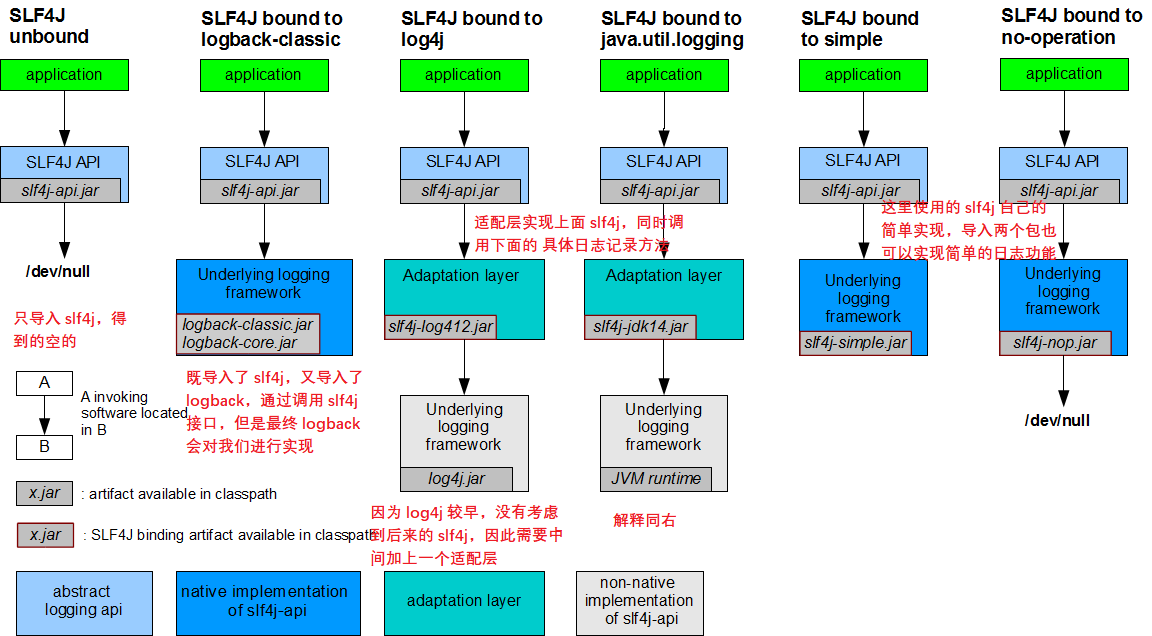
每一个日志的实现框架(如以前应用的 log4j)都有自己的配置文件。使用 slf4j 以后,配置文件还是做成日志实现框架自己本身的配置文件;相当于用谁实现就写谁的配置文件,slf4j 只是提供一个接口层;
(二)统一日志记录
如果系统实现(slf4j + logback): 但是同时该系统依赖 Spring(commons-logging)、Hibernate(jboss-logging)、MyBatis、xxxx等框架,但是框架本身底层就有日志记录还各不相同;
目标:统一日志记录,即别的框架和我一起统一使用 slf4j 进行输出;
如何让系统中所有的日志都统一到slf4j;
-
将系统中其他日志框架先排除出去;
-
用中间包来替换原有的日志框架;
-
导入slf4j 其他的具体实现;
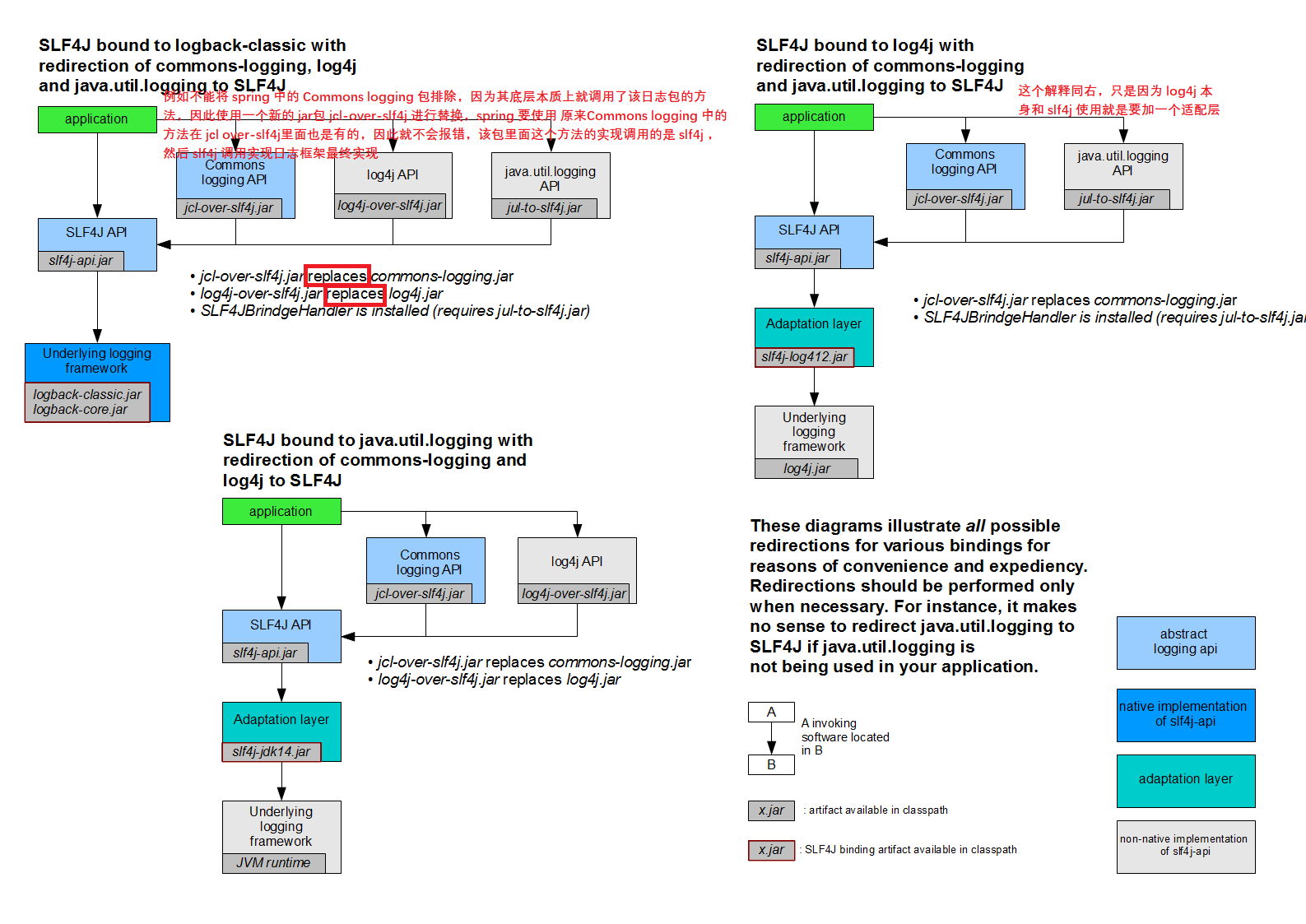
16 SpringBoot日志关系
首先导入 Maven 依赖:
<dependency>
<groupId>org.springframework.boot</groupId>
<artifactId>spring-boot-starter</artifactId>
</dependency>
SpringBoot 使用它来做日志功能;下面这个依赖中封装了所有的日志启动场景
<dependency>
<groupId>org.springframework.boot</groupId>
<artifactId>spring-boot-starter-logging</artifactId>
</dependency>
spring boot 底层依赖关系(在项目(这里是 web 项目)的 pom.xml 配置文件上生成)
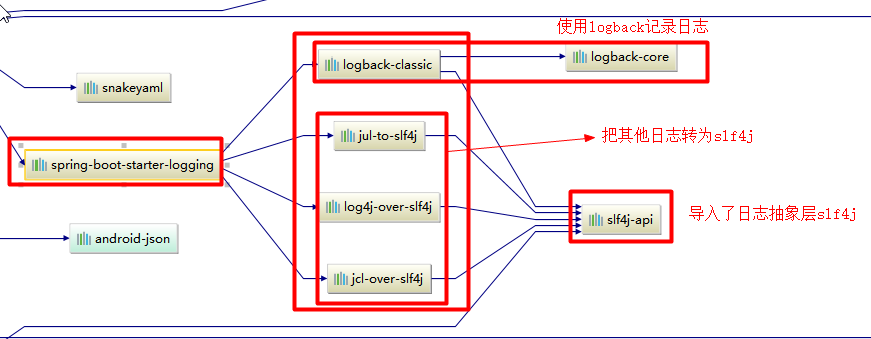
-
总结:
- SpringBoot 底层也是使用 slf4j + logback 的方式进行日志记录
- SpringBoot 也把其他的日志都替换成了slf4j(因此导入了 jul-to-slf4j 等 Jar包);
-
以中间替换包 jcl-over-slf4j.jar 为例:
首先点击 jar 包发现里面的包名仍然还是:org.apache.commons.logging,同时里面的类也是 LogFactory,下面就是该类的部分截图,可以看出该类里面的实现是调用了 SLF4JLogFactory()
@SuppressWarnings("rawtypes")
public abstract class LogFactory {
static String UNSUPPORTED_OPERATION_IN_JCL_OVER_SLF4J = "http://www.slf4j.org/codes.html#unsupported_operation_in_jcl_over_slf4j";
static LogFactory logFactory = new SLF4JLogFactory();
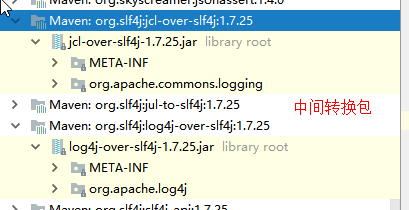
- 因此如果我们要引入其他框架,一定要把这个框架的默认日志依赖移除掉
例如Spring框架用的是commons-logging;可以在上面的图中点击:spring-boot-starter-logging,就可以跳到 pom.xml 文件中,可以看到下面的配置,确实排除了 commons-logging
<dependency>
<groupId>org.springframework</groupId>
<artifactId>spring-core</artifactId>
<exclusions>
<exclusion>
<groupId>commons-logging</groupId>
<artifactId>commons-logging</artifactId>
</exclusion>
</exclusions>
</dependency>
SpringBoot能自动适配所有的日志,而且底层使用slf4j+logback的方式记录日志,引入其他框架的时候,只需要把这个框架依赖的日志框架排除掉即可;
17 日志使用
(一)默认配置
SpringBoot 默认帮我们配置好了日志,因此空项目直接运行下面窗口中会有一系列的日志输出;
同时如果自己想配置日志输入示例如下:这里是在 测试类中配置
//日志记录器:logger
Logger logger = LoggerFactory.getLogger(getClass());
@Test
public void contextLoads() {
//日志的级别;
//由低到高 trace<debug<info<warn<error
//可以调整输出的日志级别;日志就只会在这个级别以以后的高级别生效
logger.trace("这是trace日志...");
logger.debug("这是debug日志...");
//SpringBoot默认给我们使用的是info级别的,没有指定级别包/类的就用SpringBoot默认规定的级别;
logger.info("这是info日志...");
logger.warn("这是warn日志...");
logger.error("这是error日志...");
}
日志的输出格式含义:
%d 表示日期时间,
%thread 表示线程名,
%-5level: 级别从左显示5个字符宽度
%logger{50} 表示logger名字最长50个字符,否则按照句点分割
%msg: 日志消息
%n 是换行符
示例: %d{yyyy-MM-dd HH:mm:ss.SSS} [%thread] %-5level %logger{50} - %msg%n
SpringBoot修改日志的默认配置(在 application.properties 配置文件中)
***日志的输出级别可以控制到包/类***
logging.level.com.gjxaiou=trace
***logging.path=***
***当 logging.path 没有值的时候,即不指定路径只是配置 logging.file=日志文件名,就会在当前项目下生成该日志文件名的日志;当然可以指定完整的日志文件输出路径,就会在指定路径下面输出日志文件;***
***logging.file=G:/springboot.log***
***只指定 path 不指定 file 的情况下:使用下面配置就是在当前磁盘的根路径下创建spring文件夹和里面的log文件夹;使用 spring.log 作为默认文件***
logging.path=/spring/log
***在控制台输出的日志的格式***
logging.pattern.console=%d{yyyy-MM-dd} [%thread] %-5level %logger{50} - %msg%n
***指定文件中日志输出的格式***
logging.pattern.file=%d{yyyy-MM-dd} === [%thread] === %-5level === %logger{50} ==== %msg%n
| logging.file | logging.path | Example | Description |
|---|---|---|---|
| (none) | (none) | 只在控制台输出 | |
| 指定文件名 | (none) | my.log | 输出日志到my.log文件 |
| (none) | 指定目录 | /var/log | 输出到指定目录的 spring.log 文件中 |
(二)指定配置
给类路径下放上每个日志框架自己的配置文件即可,这样SpringBoot就不使用他默认配置的了,文件名如下:
| Logging System | Customization |
|---|---|
| Logback | logback-spring.xml, logback-spring.groovy, logback.xml or logback.groovy |
| Log4j2 | log4j2-spring.xml or log4j2.xml |
| JDK (Java Util Logging) | logging.properties |
logback.xml:直接就被日志框架识别了,相当于绕过了 springboot;
logback-spring.xml:日志框架就不直接加载日志的配置项(因为日志框架只认识 logback.xml),由SpringBoot解析日志配置,就可以使用SpringBoot的高级Profile功能
<springProfile name="staging">
<!-- configuration to be enabled when the "staging" profile is active -->
可以指定某段配置只在某个环境下生效
</springProfile>
如在开发环境输入》》》不在开发环境输出》》》:直接运行就行,这里肯定不是开发环境(在 application.properties 中使用 spring.profiles.active=dev 可以进行指定)
<appender name="stdout" class="ch.qos.logback.core.ConsoleAppender">
<!--
日志输出格式:
%d表示日期时间,
%thread表示线程名,
%-5level:级别从左显示5个字符宽度
%logger{50} 表示logger名字最长50个字符,否则按照句点分割。
%msg:日志消息,
%n是换行符
-->
<layout class="ch.qos.logback.classic.PatternLayout">
<springProfile name="dev">
<pattern>%d{yyyy-MM-dd HH:mm:ss.SSS} ----> [%thread] ---> %-5level %logger{50} - %msg%n</pattern>
</springProfile>
<springProfile name="!dev">
<pattern>%d{yyyy-MM-dd HH:mm:ss.SSS} ==== [%thread] ==== %-5level %logger{50} - %msg%n</pattern>
</springProfile>
</layout>
</appender>
如果使用logback.xml作为日志配置文件,还要使用profile功能,会有以下错误
no applicable action for [springProfile]
18 切换日志框架
可以按照slf4j的日志适配图(见上面),进行相关的切换;
slf4j+log4j的方式;不推荐
<dependency>
<groupId>org.springframework.boot</groupId>
<artifactId>spring-boot-starter-web</artifactId>
<exclusions>
<exclusion>
<artifactId>logback-classic</artifactId>
<groupId>ch.qos.logback</groupId>
</exclusion>
<exclusion>
<artifactId>log4j-over-slf4j</artifactId>
<groupId>org.slf4j</groupId>
</exclusion>
</exclusions>
</dependency>
<dependency>
<groupId>org.slf4j</groupId>
<artifactId>slf4j-log4j12</artifactId>
</dependency>
切换为log4j2:不推荐
<dependency>
<groupId>org.springframework.boot</groupId>
<artifactId>spring-boot-starter-web</artifactId>
<exclusions>
<exclusion>
<artifactId>spring-boot-starter-logging</artifactId>
<groupId>org.springframework.boot</groupId>
</exclusion>
</exclusions>
</dependency>
<dependency>
<groupId>org.springframework.boot</groupId>
<artifactId>spring-boot-starter-log4j2</artifactId>
</dependency>
19 简介
-
使用 SpringBoot 进行 WEB 开发步骤:
- 创建 SpringBoot 应用,选中我们需要的模块;
- SpringBoot 已经默认将这些场景配置好了,只需要在配置文件中指定少量配置就可以运行起来;
- 自己编写业务代码;
-
自动配置原理
使用自动配置原理还应该考虑一下这个场景 SpringBoot 帮我们配置了什么?能不能修改?能修改哪些配置?能不能扩展?
- xxxxAutoConfiguration:帮我们给容器中自动配置组件;
- xxxxProperties:配置类来封装配置文件的内容;
20 Spring Boot 对静态资源的映射规则
在 SpringBoot 中关于 SpringMVC 的所有配置都在 WebMvcAutoConfiguration.java (使用 Ctrl + n 全局搜索该文件名即可)中,下面仅仅是静态资源配置的相关代码
public void addResourceHandlers(ResourceHandlerRegistry registry) {
if (!this.resourceProperties.isAddMappings()) {
logger.debug("Default resource handling disabled");
} else {
Integer cachePeriod = this.resourceProperties.getCachePeriod();
if (!registry.hasMappingForPattern("/webjars/**")) {
this.customizeResourceHandlerRegistration(
registry.addResourceHandler(new String[]{"/webjars/**"})
.addResourceLocations(new String[]{"classpath:/META-INF/resources/webjars/"})
.setCachePeriod(cachePeriod));
}
String staticPathPattern = this.mvcProperties.getStaticPathPattern();
//静态资源文件夹映射
if (!registry.hasMappingForPattern(staticPathPattern)) {
this.customizeResourceHandlerRegistration(
registry.addResourceHandler(new String[]{staticPathPattern})
.addResourceLocations(this.resourceProperties.getStaticLocations())
.setCachePeriod(cachePeriod));
}
}
}
//配置欢迎页映射
@Bean
public WelcomePageHandlerMapping welcomePageHandlerMapping(
ResourceProperties resourceProperties) {
return new WelcomePageHandlerMapping(resourceProperties.getWelcomePage(),
this.mvcProperties.getStaticPathPattern());
}
//配置喜欢的图标
@Configuration
@ConditionalOnProperty(
value = {"spring.mvc.favicon.enabled"},
matchIfMissing = true
)
public static class FaviconConfiguration {
private final ResourceProperties resourceProperties;
public FaviconConfiguration(ResourceProperties resourceProperties) {
this.resourceProperties = resourceProperties;
}
@Bean
public SimpleUrlHandlerMapping faviconHandlerMapping() {
SimpleUrlHandlerMapping mapping = new SimpleUrlHandlerMapping();
mapping.setOrder(-2147483647);
mapping.setUrlMap(Collections.singletonMap("**/favicon.ico", this.faviconRequestHandler()));
return mapping;
}
@Bean
public ResourceHttpRequestHandler faviconRequestHandler() {
ResourceHttpRequestHandler requestHandler = new ResourceHttpRequestHandler();
requestHandler.setLocations(this.resourceProperties.getFaviconLocations());
return requestHandler;
}
}
上面代码中的设置配置在 resourceProperties.java 中,例如下面的部分文件设置(点击resourcesProperties 文件即可) ,可以设置其所有的属性值,例如: 可以设置和静态资源有关的参数,缓存时间等
@ConfigurationProperties(prefix = "spring.resources", ignoreUnknownFields = false)
public class ResourceProperties implements ResourceLoaderAware {
private static final String[] SERVLET_RESOURCE_LOCATIONS = { "/" };
private static final String[] CLASSPATH_RESOURCE_LOCATIONS = {
"classpath:/META-INF/resources/", "classpath:/resources/",
"classpath:/static/", "classpath:/public/" };
private static final String[] RESOURCE_LOCATIONS;
static {
RESOURCE_LOCATIONS = new String[CLASSPATH_RESOURCE_LOCATIONS.length
+ SERVLET_RESOURCE_LOCATIONS.length];
System.arraycopy(SERVLET_RESOURCE_LOCATIONS, 0, RESOURCE_LOCATIONS, 0,
SERVLET_RESOURCE_LOCATIONS.length);
System.arraycopy(CLASSPATH_RESOURCE_LOCATIONS, 0, RESOURCE_LOCATIONS,
SERVLET_RESOURCE_LOCATIONS.length, CLASSPATH_RESOURCE_LOCATIONS.length);
}
private String[] staticLocations = RESOURCE_LOCATIONS;
private Integer cachePeriod;
private boolean addMappings = true;
private final Chain chain = new Chain();
private ResourceLoader resourceLoader;
(一)映射规则一(WebJars)
从第一段代码中得出:所有 /webjars/**的请求 ,都去 classpath:/META-INF/resources/webjars/ 找资源;
-
webjars:以 jar 包的方式引入静态资源,以前是放在 webapp 目录下面即可;
-
需要使用什么,从官方网站中引入响应的 jar 包即可,这里以 jQuery 为例,需要引入下面的jar包,下图为该jar 包中具体的内容;
<!--引入jquery-webjar-->在访问的时候只需要写 webjars 下面资源的名称即可
<dependency>
<groupId>org.webjars</groupId>
<artifactId>jquery</artifactId>
<version>3.4.1</version>
</dependency>
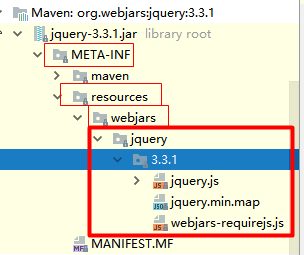
测试:如果访问:localhost:8080/webjars/jquery/3.3.1/jquery.js 就能访问这里面的 js 了
(二)映射规则二:(项目任意路径)
-
上述代码块第一个第13行中:mvcProperties 文件中的 staticPathPattern 值为:
/**(源代码为 WebMvcProperties.java 中对应的代码:private String staticPathPattern = "/**";),这就是第二种映射规则; -
"/**" 访问当前项目的任何资源,都去(静态资源的文件夹)找映射 即如果该路径没有人进行处理就去下面文件夹中找("/":表示当前项目的根路径)
"classpath:/META-INF/resources/",
"classpath:/resources/",
"classpath:/static/",
"classpath:/public/"
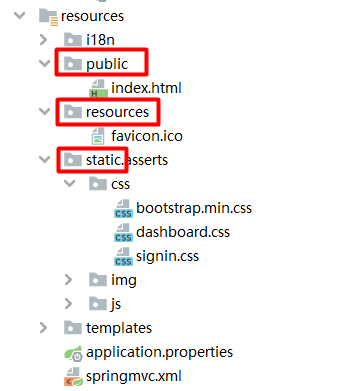
例如访问:localhost:8080/static/asserts/css/signin.css 就是可以访问到资源的;
(三)映射规则三:欢迎页
欢迎页; 静态资源文件夹下的所有index.html页面;被"/**"映射;
localhost:8080/ 找index页面
(四)映射规则四:网页标签的小图标
所有的 **/favicon.ico 都是在静态资源文件下找;
(五)自定义映射规则
当然可以自己在 application.properties 中通过 spring.resource.static-locations=classpath:/hello/设置路径在 /hello/下面
21 模板引擎
因为 springboot 使用内嵌的 tomcat,不支持 jsp 等等,因此可以使用模板引擎。
现有的模板引擎包括:JSP、Velocity、Freemarker、Thymeleaf
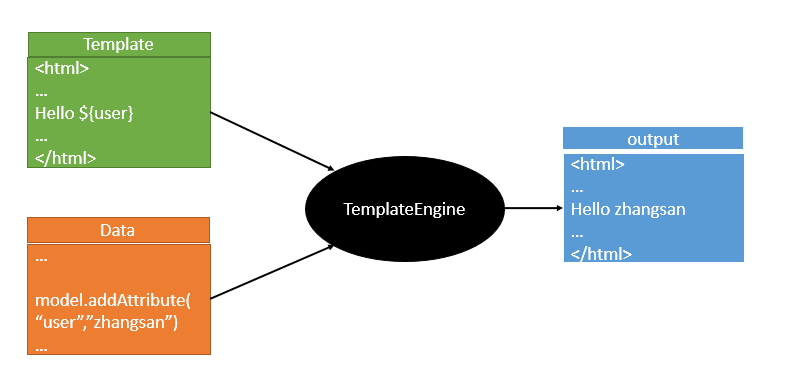
SpringBoot 推荐的 Thymeleaf,因为其语法更简单,功能更强大;
(一)引入thymeleaf
<dependency>
<groupId>org.springframework.boot</groupId>
<artifactId>spring-boot-starter-thymeleaf</artifactId>
</dependency>
<!--切换 thymeleaf 版本-->
<properties>
<thymeleaf.version>3.0.11.RELEASE</thymeleaf.version>
<thymeleaf-extras-java8time.version>3.0.4.RELEASE</thymeleaf-extras-java8time.version>
<thymeleaf-extras-springsecurity.version>3.0.4.RELEASE</thymeleaf-extras-springsecurity.version>
<!-- 下面是布局功能的支持程序,针对 thymeleaf3 主程序需要 layout2 以上版本 -->
<thymeleaf-layout-dialect.version>2.4.1</thymeleaf-layout-dialect.version>
</properties>
(二)Thymeleaf 使用
自动配置规则在 spring-boot-autoconfigure-2.2.1.RELEASE.jar!\org\springframework\boot\autoconfigure\thymeleaf\ThymeleafAutoConfiguration.java 中,下面是其对应的 ThymeleafProperties.java 中封装着其默认规则,下面是部分代码
@ConfigurationProperties(prefix = "spring.thymeleaf")
public class ThymeleafProperties {
private static final Charset DEFAULT_ENCODING = Charset.forName("UTF-8");
private static final MimeType DEFAULT_CONTENT_TYPE = MimeType.valueOf("text/html");
// 默认的前缀和后缀
public static final String DEFAULT_PREFIX = "classpath:/templates/";
public static final String DEFAULT_SUFFIX = ".html";
上面的含义:只要我们把HTML页面放在 classpath:/templates/目录下,thymeleaf 就能自动渲染;
例如在 helloController.java 中输入:
package com.gjxaiou.springboot.controller;
@Controller
public class HelloController {
@RequestMapping("/success")
public String success(){
return "success";
}
}
上面代码在 templates文件夹下面新建:success.html ,访问:localhost:8080/success就可以到达该页面;
- 在 HTML 中的使用
-
导入thymeleaf的名称空间(下面两段代码都在在 sucess.html 中)
<html lang="en" xmlns:th="http://www.thymeleaf.org"> -
使用thymeleaf语法;
-
<!DOCTYPE html>
<html lang="en" xmlns:th="http://www.thymeleaf.org">
<head>
<meta charset="UTF-8">
<title>Title</title>
</head>
<body>
<h1>成功!</h1>
<!--th:text 将div里面的文本内容设置为 -->
<div th:text="${hello}">这是显示欢迎信息</div>
<!--这里直接打开 html 文件显示内容为:这是显示欢迎信息,如果通过模板解析访问显示内容为:你好,会代替后面的值-->
</body>
</html>
对应的controller 修改为:
package com.gjxaiou.springboot.controller;
@Controller
public class HelloController {
//查出用户数据,在页面展示
@RequestMapping("/success")
public String success(Map<String,Object> map){
map.put("hello","<h1>你好</h1>");
return "success";
}
}
(三)语法规则
-
th:任意html属性:来替换原生属性(即 HTML 中默认的属性)的值示例:th:text:改变当前元素里面的文本内容;
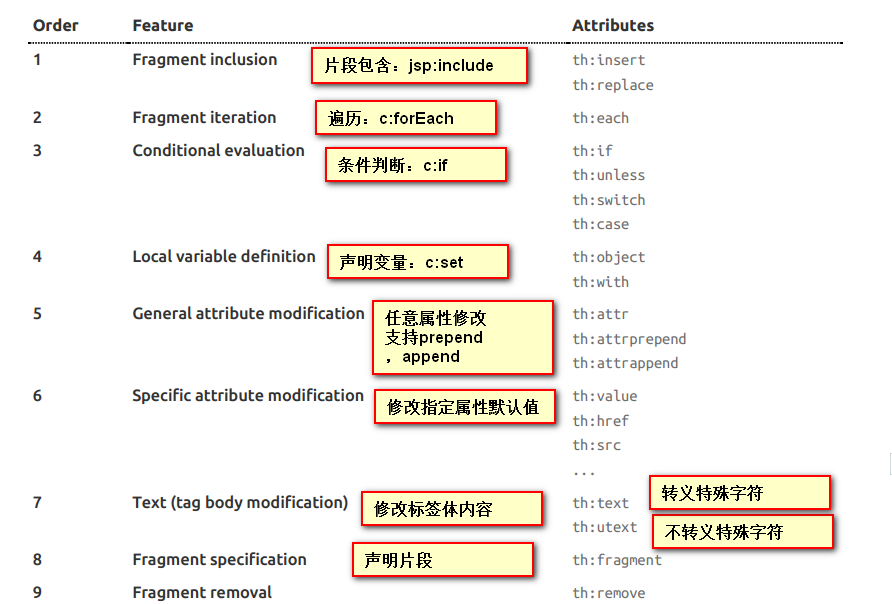
- 支持的表达式语法:
Simple expressions:(表达式语法)
Variable Expressions: ${...}:获取变量值;底层就是OGNL;
1)、可以获取对象的属性、调用方法
2)、使用内置的基本对象:(即在 ${}中可以加入下面这些)
#ctx : the context object.
#vars: the context variables.
#locale : the context locale.
#request : (only in Web Contexts) the HttpServletRequest object.
#response : (only in Web Contexts) the HttpServletResponse object.
#session : (only in Web Contexts) the HttpSession object.
#servletContext : (only in Web Contexts) the ServletContext object.
示例:${session.foo}
3)、内置的一些工具对象:
***execInfo : information about the template being processed.***
***messages : methods for obtaining externalized messages inside variables expressions, in the same way as they would be obtained using #{…} syntax.
uris : methods for escaping parts of URLs/URIs
conversions : methods for executing the configured conversion service (if any).
dates : methods for java.util.Date objects: formatting, component extraction, etc.
calendars : analogous to #dates , but for java.util.Calendar objects.
numbers : methods for formatting numeric objects.
strings : methods for String objects: contains, startsWith, prepending/appending, etc.
objects : methods for objects in general.
bools : methods for boolean evaluation.
arrays : methods for arrays.
lists : methods for lists.
sets : methods for sets.
maps : methods for maps.
aggregates : methods for creating aggregates on arrays or collections.
ids : methods for dealing with id attributes that might be repeated (for example, as a result of an iteration).***
Selection Variable Expressions: *{...}:选择表达式:和${}在功能上是一样;
补充功能:配合 th:object="${session.user}:
<div th:object="${session.user}">
<p>Name: <span th:text="*{firstName}">Sebastian</span>.</p>
<p>Surname: <span th:text="*{lastName}">Pepper</span>.</p>
<p>Nationality: <span th:text="*{nationality}">Saturn</span>.</p>
</div>
对应于使用上面的 ${...}写法为:
<div>
<p>Name: <span th:text="${session.user.firstName}">Sebastian</span>.</p>
<p>Surname: <span th:text="${session.user.lastName}">Pepper</span>.</p>
<p>Nationality: <span th:text="${session.user.nationality}">Saturn</span>.</p>
</div>
Message Expressions: #{...}:获取国际化内容
Link URL Expressions: @{...}:定义URL;
Fragment Expressions: ~{...}:片段引用表达式
Literals(字面量)
Text literals: 'one text' , 'Another one!' ,…
Number literals: 0 , 34 , 3.0 , 12.3 ,…
Boolean literals: true , false
Null literal: null
Literal tokens: one , sometext , main ,…
Text operations:(文本操作)
String concatenation: +
Literal substitutions: |The name is ${name}|
Arithmetic operations:(数学运算)
Binary operators: + , - , * , / , %
Minus sign (unary operator): -
Boolean operations:(布尔运算)
Binary operators: and , or
Boolean negation (unary operator): ! , not
Comparisons and equality:(比较运算)
Comparators: > , < , >= , <= ( gt , lt , ge , le )
Equality operators: == , != ( eq , ne )
Conditional operators:条件运算(三元运算符)
If-then: (if) ? (then)
If-then-else: (if) ? (then) : (else)
Default: (value) ?: (defaultvalue)
Special tokens:
No-Operation: _
使用示例:
package com.gjxaiou.springboot.controller;
@Controller
public class HelloController {
//查出用户数据,在页面展示
@RequestMapping("/success")
public String success(Map<String,Object> map){
map.put("hello","<h1>你好</h1>");
map.put("users",Arrays.asList("zhangsan","lisi","wangwu"));
return "success";
}
}
对应的 success.html 文件为:
<!DOCTYPE html>
<html lang="en" xmlns:th="http://www.thymeleaf.org">
<head>
<meta charset="UTF-8">
<title>Title</title>
</head>
<body>
<div th:text="${hello}"></div>
<div th:utext="${hello}"></div>
<hr/>
<!-- th:each每次遍历都会生成当前这个标签: 最终形成3个h4 -->
<h4 th:text="${user}" th:each="user:${users}"></h4>
<hr/>
<!--每个结果放在 span 中,最终是 1 个<h4>里面 3个 span 标签-->
<h4>
<span th:each="user:${users}"> [[${user}]] </span>
</h4>
</body>
</html>
22 SpringMVC 自动配置
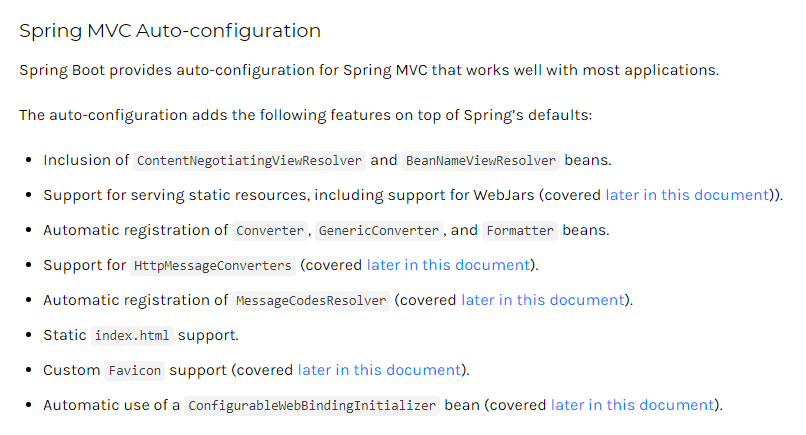
(一)Spring MVC 的 auto-configuration
Spring Boot 自动配置好了 SpringMVC以下是SpringBoot 对 SpringMVC的默认配置(见 Reference 文档 P107/519):下面的所有自动配置都在(WebMvcAutoConfiguration)文件中
-
Inclusion(包含) of
ContentNegotiatingViewResolverandBeanNameViewResolverbeans.-
自动配置了ViewResolver(视图解析器:根据方法的返回值得到视图对象(View),视图对象决定如何渲染(转发?重定向?))
-
ContentNegotiatingViewResolver:这个类是组合所有的视图解析器的;
-
如何定制视图解析器:我们可以自己给容器中添加一个视图解析器;然后ContentNegotiatingViewResolver 自动的将其组合进来;
验证:在主类中自定义视图解析器,然后使用 @Bean 就将其加入容器中;
-
package com.gjxaiou.springboot;
@SpringBootApplication
public class SpringBoot04WebRestfulcrudApplication {
public static void main(String[] args) {
SpringApplication.run(SpringBoot04WebRestfulcrudApplication.class, args);
}
// 添加到容器中
@Bean
public ViewResolver myViewReolver(){
return new MyViewResolver();
}
public static class MyViewResolver implements ViewResolver{
@Override
public View resolveViewName(String viewName, Locale locale) throws Exception {
return null;
}
}
}
然后全局搜索:DispatcherServlet,来到 1000行(ctrl + G ) 的 doDispatch() 方法上打断点然后调试,访问任意路径看自定义的视图解析器是否在里面;
查看 Valiables 中的 viewResolvers 中就应该有自己定义的视图解析器
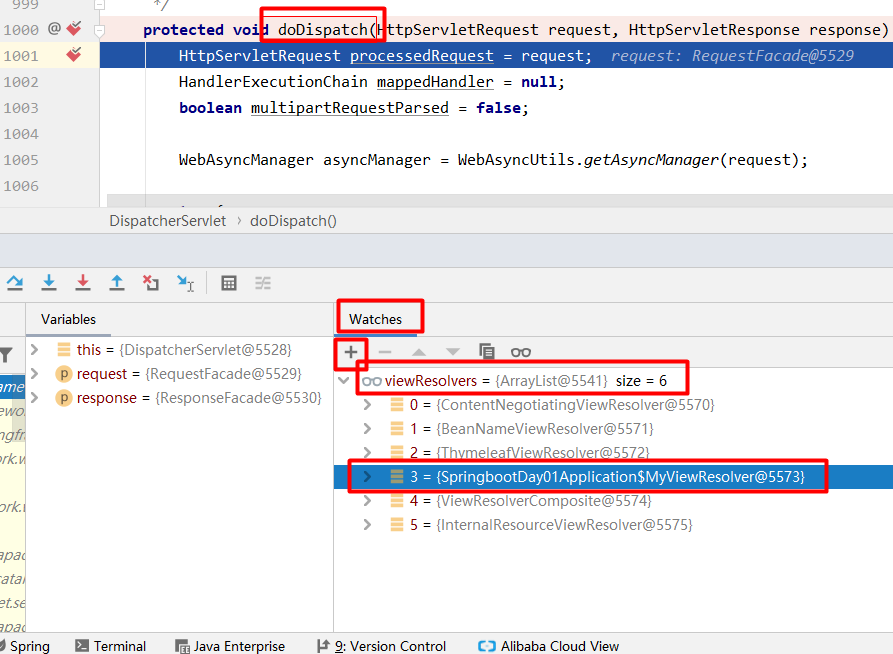
-
Support for serving static resources, including support for WebJars (see below).静态资源文件夹路径,webjars
-
Static
index.htmlsupport. 静态首页访问 -
Custom
Faviconsupport (see below). 支持 favicon.ico 自定义 -
Automatic use of
Converter,GenericConverter,Formatterbeans;就是页面带来的数据格式要转换成其他格式,例如页面带来一个 18(文本类型)要转换为 integer 类型等等;Converter:转换器; public String hello(User user):类型转换使用 ConverterFormatter格式化器; 2017.12.17===Date;
@Bean
@ConditionalOnProperty(prefix = "spring.mvc", name = "date-format")//在文件中配置日期格式化的规则
public Formatter<Date> dateFormatter() {
return new DateFormatter(this.mvcProperties.getDateFormat());//日期格式化组件
}
自己添加的格式化器转换器,我们只需要放在容器中即可,因为它也是遍历 Converter 类型;
-
Support for
HttpMessageConverters(see below)。-
HttpMessageConverter:是SpringMVC用来转换Http请求和响应的;如方法返回User对象,想以Json数据形式写出去;
-
HttpMessageConverters是从容器中确定;获取所有的HttpMessageConverter;自己给容器中添加HttpMessageConverter,只需要将自己的组件注册容器中(@Bean,@Component)
-
-
Automatic registration of
MessageCodesResolver(see below).定义错误代码生成规则 -
Automatic use of a
ConfigurableWebBindingInitializerbean (see below).我们可以配置一个ConfigurableWebBindingInitializer来替换默认的;(需要添加到容器中) ,
(二)扩展SpringMVC
Spring MVC 中拓展方式:
<mvc:view-controller path="/hello" view-name="success"/>
<mvc:interceptors>
<mvc:interceptor>
<mvc:mapping path="/hello"/>
<bean></bean>
</mvc:interceptor>
</mvc:interceptors>
Spring Boot 中方式:编写一个配置类(@Configuration),该类是 WebMvcConfigurerAdapter 类型;但是不能标注 @EnableWebMvc;
既保留了所有的自动配置,也能用我们扩展的配置;
// 使用 WebMvcConfigurerAdapter 可以来扩展 SpringMVC 的功能
@Configuration
public class MyMvcConfig extends WebMvcConfigurerAdapter {
@Override
public void addViewControllers(ViewControllerRegistry registry) {
// super.addViewControllers(registry);
//浏览器发送 /gjxaiou 请求来到 success
registry.addViewController("/gjxaiou").setViewName("success");
}
}
原理:
-
WebMvcAutoConfiguration 是 Spring MVC 的自动配置类
-
在做其他自动配置时会导入:@Import(EnableWebMvcConfiguration.class)
@Configuration
public static class EnableWebMvcConfiguration extends DelegatingWebMvcConfiguration {
private final WebMvcConfigurerComposite configurers = new WebMvcConfigurerComposite();
//从容器中获取所有的WebMvcConfigurer
@Autowired(required = false)
public void setConfigurers(List<WebMvcConfigurer> configurers) {
if (!CollectionUtils.isEmpty(configurers)) {
this.configurers.addWebMvcConfigurers(configurers);
//一个参考实现;将所有的WebMvcConfigurer相关配置都来一起调用;
@Override
// public void addViewControllers(ViewControllerRegistry registry) {
// for (WebMvcConfigurer delegate : this.delegates) {
// delegate.addViewControllers(registry);
// }
}
}
}
-
容器中所有的 WebMvcConfigurer 都会一起起作用;
-
我们的配置类也会被调用;
效果:SpringMVC 的自动配置和我们的扩展配置都会起作用;
(三)全面接管SpringMVC(不推荐)
SpringBoot 对 SpringMVC 的自动配置都不需要,所有都是我们自己配置;例如基本的静态资源不能使用了,所有路径都需要自己进行配置;
我们需要在配置类中添加@EnableWebMvc即可;
//使用WebMvcConfigurerAdapter可以来扩展SpringMVC的功能
@EnableWebMvc
@Configuration
public class MyMvcConfig extends WebMvcConfigurerAdapter {
@Override
public void addViewControllers(ViewControllerRegistry registry) {
// 浏览器发送 /gjxaiou 请求来到 success
registry.addViewController("/gjxaiou").setViewName("success");
}
}
原理:
为什么@EnableWebMvc自动配置就失效了;
- @EnableWebMvc 的代码为:(点击)
@Retention(RetentionPolicy.RUNTIME)
@Target(ElementType.TYPE)
@Documented
@Import(DelegatingWebMvcConfiguration.class)
public @interface EnableWebMvc {
}
- 由上面的 @Import() 中的 DelegatingWebMvcConfiguration.class ,其代码为:
@Configuration
public class DelegatingWebMvcConfiguration extends WebMvcConfigurationSupport {
- 下面是 Spring Boot 的自动配置类:WebMvcAutoConfiguration
@Configuration
@ConditionalOnWebApplication
@ConditionalOnClass({ Servlet.class, DispatcherServlet.class,
WebMvcConfigurerAdapter.class })
//容器中没有这个组件的时候,这个自动配置类才生效
@ConditionalOnMissingBean(WebMvcConfigurationSupport.class)
@AutoConfigureOrder(Ordered.HIGHEST_PRECEDENCE + 10)
@AutoConfigureAfter({ DispatcherServletAutoConfiguration.class,
ValidationAutoConfiguration.class })
public class WebMvcAutoConfiguration {
-
总结:
@EnableWebMvc里面的@Import(DelegatingWebMvcConfiguration.class)将 里面类的父类:WebMvcConfigurationSupport组件导入进来,所有相当于@ConditionalOnMissingBean(WebMvcConfigurationSupport.class)就是不符合的,因此自动配置类就失效了 ; -
导入的WebMvcConfigurationSupport 只是 SpringMVC 最基本的功能;
23 如何修改 SpringBoot 的默认配置
-
方式一:SpringBoot 在自动配置很多组件的时候,先看容器中有没有用户自己配置的(@Bean、@Component)如果有就用用户配置的,如果没有,才自动配置;如果有些组件可以有多个(ViewResolver)将用户配置的和自己默认的组合起来;
-
方式二:在 SpringBoot 中会有非常多的 xxxConfigurer 帮助我们进行扩展配置;
-
方式三:在 SpringBoot 中会有很多的 xxxCustomizer 帮助我们进行定制配置;
24 RestfulCRUD 项目
(一)设置默认访问首页
项目中有两个 index.html 文件,位置分别为:resources.public.index.html 和resources.templates.index.html,要求默认是访问后者的 index.html 文件;
下面的两种方式都是默认使用了 thymeleaf 模板引擎;
- 方法一:编写单独的控制器进行路径映射
@Controller
public class HelloController {
// 不管是访问当前项目还是访问当前项目的 index.html
@RequestMapping({"/","/index.html"})
public String index(){
return "index";
}
}
- 方法二:添加视图映射(只需要将组件注册到容器中即可)
@Configuration
public class MyMvcConfig extends WebMvcConfigurerAdapter {
//所有的WebMvcConfigurerAdapter组件都会一起起作用
@Bean //将组件注册在容器
public WebMvcConfigurerAdapter webMvcConfigurerAdapter(){
WebMvcConfigurerAdapter adapter = new WebMvcConfigurerAdapter() {
@Override
public void addViewControllers(ViewControllerRegistry registry) {
registry.addViewController("/").setViewName("index");
registry.addViewController("/index.html").setViewName("index");
}
};
return adapter;
}
}
(二)国际化
-
以前springmvc 配置方式:
- 编写国际化配置文件;
- 使用ResourceBundleMessageSource管理国际化资源文件;
- 在页面使用fmt:message取出国际化内容;
-
使用 Spring Boot 实现步骤:
- 首先编写国际化配置文件,抽取页面需要显示的国际化消息(然后分别配置属性文件)
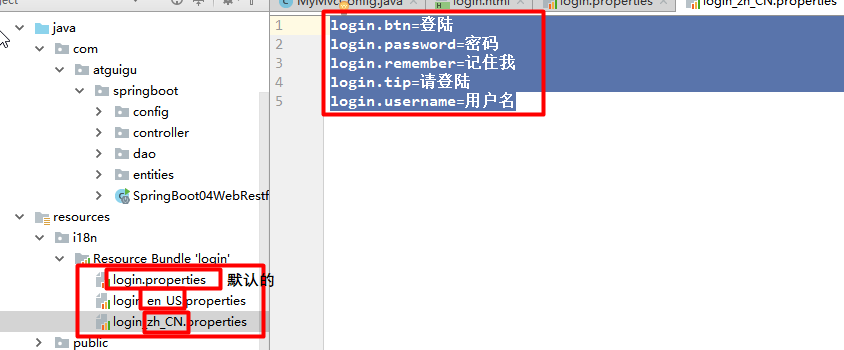
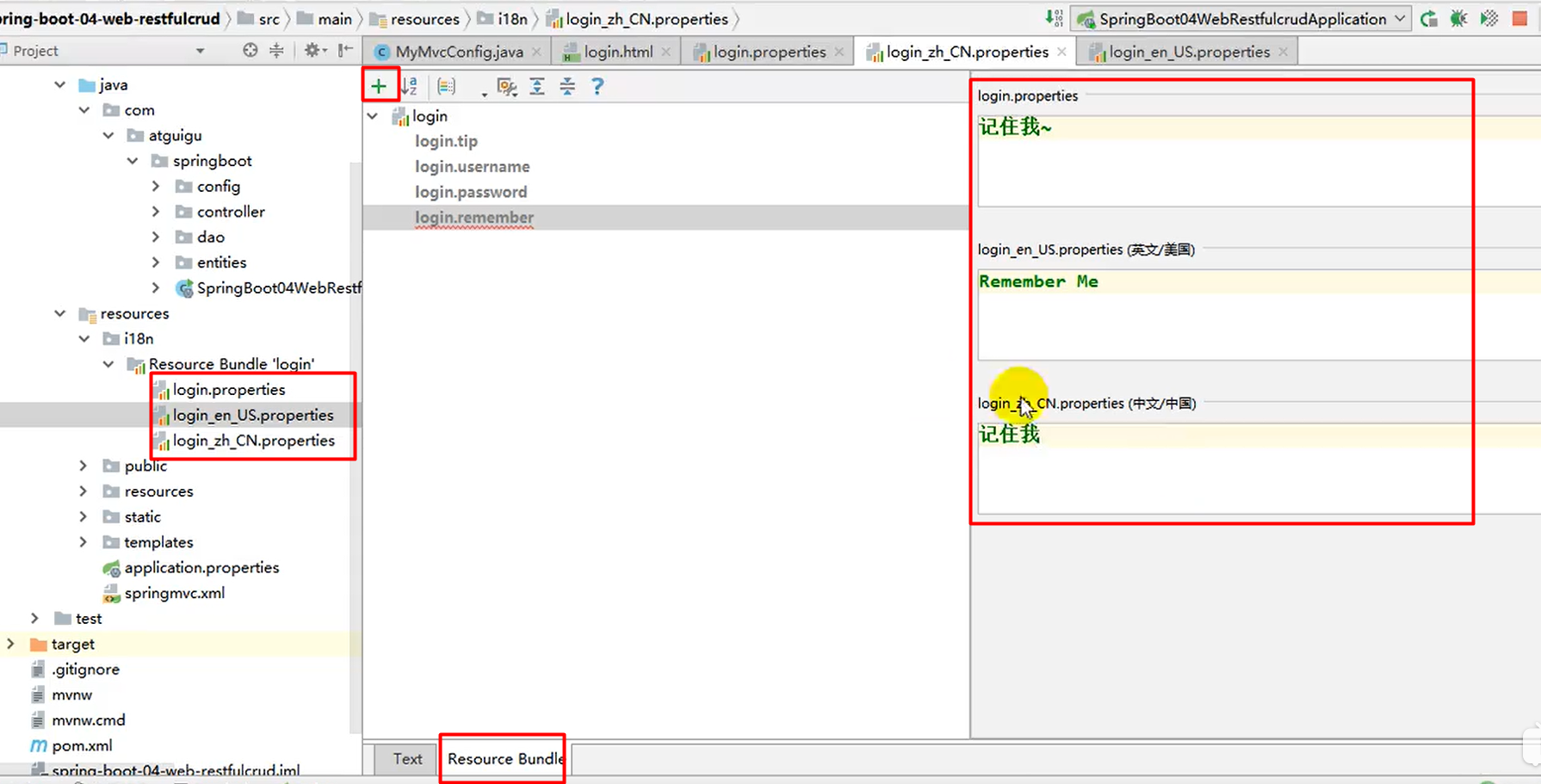
- SpringBoot自动配置好了管理国际化资源文件的组件;
@ConfigurationProperties(prefix = "spring.messages")
public class MessageSourceAutoConfiguration {
//我们的配置文件可以直接放在类路径下叫messages.properties;(因为默认名为 message)
private String basename = "messages";
@Bean
public MessageSource messageSource() {
ResourceBundleMessageSource messageSource = new ResourceBundleMessageSource();
if (StringUtils.hasText(this.basename)) {
//设置国际化资源文件的基础名(去掉语言国家代码的)
messageSource.setBasenames(StringUtils.commaDelimitedListToStringArray(
StringUtils.trimAllWhitespace(this.basename)));
}
if (this.encoding != null) {
messageSource.setDefaultEncoding(this.encoding.name());
}
messageSource.setFallbackToSystemLocale(this.fallbackToSystemLocale);
messageSource.setCacheSeconds(this.cacheSeconds);
messageSource.setAlwaysUseMessageFormat(this.alwaysUseMessageFormat);
return messageSource;
}
因为没有使用系统默认的文件名,因此需要在 application.properties 中配置:`spring.messages.basename=i18n.login`,注意后面是去掉国家代码的部分(即取所有配置文件去掉后面的语言和国家的前面公共部分);
- 在页面获取国际化的值;
在页面中(login.html)取值,例如 19行的:`th:text="#{login.username}"`(如果出现乱码,注意配置在 IDEA 中配置编码)
<!DOCTYPE html>
<html lang="en" xmlns:th="http://www.thymeleaf.org">
<head>
<meta http-equiv="Content-Type" content="text/html; charset=UTF-8">
<meta name="viewport" content="width=device-width, initial-scale=1, shrink-to-fit=no">
<meta name="description" content="">
<meta name="author" content="">
<title>Signin Template for Bootstrap</title>
<!-- Bootstrap core CSS -->
<link href="asserts/css/bootstrap.min.css" th:href="@{/webjars/bootstrap/4.0.0/css/bootstrap.css}" rel="stylesheet">
<!-- Custom styles for this template -->
<link href="asserts/css/signin.css" th:href="@{/asserts/css/signin.css}" rel="stylesheet">
</head>
<body class="text-center">
<form class="form-signin" action="dashboard.html">
<img class="mb-4" th:src="@{/asserts/img/bootstrap-solid.svg}" src="asserts/img/bootstrap-solid.svg" alt="" width="72" height="72">
<h1 class="h3 mb-3 font-weight-normal" th:text="#{login.tip}" >Please sign in</h1>
<label class="sr-only" th:text="#{login.username}">Username</label>
<input type="text" class="form-control" placeholder="Username" th:placeholder="#{login.username}" required="" autofocus="">
<label class="sr-only" th:text="#{login.password}">Password</label>
<input type="password" class="form-control" placeholder="Password" th:placeholder="#{login.password}" required="">
<div class="checkbox mb-3">
<label>
<input type="checkbox" value="remember-me"/> [[#{login.remember}]]
</label>
</div>
<button class="btn btn-lg btn-primary btn-block" type="submit" th:text="#{login.btn}">Sign in</button>
<p class="mt-5 mb-3 text-muted">© 2017-2018</p>
<a class="btn btn-sm">中文</a>
<a class="btn btn-sm">English</a>
</form>
</body>
</html>
效果:根据浏览器语言设置的信息切换了国际化;
- 国际化实现原理:
国际化 Locale(区域信息对象);springMVC 中的LocaleResolver(获取区域信息对象);
springboot 默认也配置了区域信息解析器,如下:默认的就是根据请求头(浏览器 F12 中的Request Header 中的 Accept-Language中可以看出)带来的区域信息获取 Locale 进行国际化
@Bean
@ConditionalOnMissingBean
@ConditionalOnProperty(prefix = "spring.mvc", name = "locale")
public LocaleResolver localeResolver() {
if (this.mvcProperties
.getLocaleResolver() == WebMvcProperties.LocaleResolver.FIXED) {
return new FixedLocaleResolver(this.mvcProperties.getLocale());
}
AcceptHeaderLocaleResolver localeResolver = new AcceptHeaderLocaleResolver();
localeResolver.setDefaultLocale(this.mvcProperties.getLocale());
return localeResolver;
}
4)、点击链接切换国际化,需要自己写一个 LocalResolver ,以下面的为例:
/**
* 可以在连接上携带区域信息
*/
public class MyLocaleResolver implements LocaleResolver {
@Override
public Locale resolveLocale(HttpServletRequest request) {
String l = request.getParameter("local");
Locale locale = Locale.getDefault();
if(!StringUtils.isEmpty(l)){
String[] split = l.split("_");
// split[0]是语言代码,后面那个是国家代码
locale = new Locale(split[0],split[1]);
}
return locale;
}
@Override
public void setLocale(HttpServletRequest request, HttpServletResponse response, Locale locale) {
}
}
// 这里的方法名不能改变
@Bean
public LocaleResolver localeResolver(){
return new MyLocaleResolver();
}
}
对应的 html 也要更改:实现点击 中文显示中文,点击 English 显示英文
<button class="btn btn-lg btn-primary btn-block" type="submit" th:text="#{login.btn}">Sign in</button>
<p class="mt-5 mb-3 text-muted">© 2017-2018</p>
<a class="btn btn-sm" th:href="@{/index.html(local='zh_CN')}">中文</a>
<a class="btn btn-sm" th:href="@{/index.html(local='en_US')}">English</a>
</form>
(三)登陆
首先修改 html 中的路径,下面是从 index.html 的15行开始;
<body class="text-center">
<!--当有一个请求为:/user/login,并且请求方式为:POST -->
<form class="form-signin" action="dashboard.html" th:action="@{/user/login}" method="post">
<img class="mb-4" th:src="@{/asserts/img/bootstrap-solid.svg}" src="asserts/img/bootstrap-solid.svg" alt="" width="72" height="72">
<h1 class="h3 mb-3 font-weight-normal" th:text="#{login.tip}">Please sign in</h1>
<!--判断-->
<p style="color: red" th:text="${msg}" th:if="${not #strings.isEmpty(msg)}"></p>
<label class="sr-only" th:text="#{login.username}">Username</label>
<input type="text" name="username" class="form-control" placeholder="Username" th:placeholder="#{login.username}" required="" autofocus="">
<label class="sr-only" th:text="#{login.password}">Password</label>
<input type="password" name="password" class="form-control" placeholder="Password" th:placeholder="#{login.password}" required="">
<div class="checkbox mb-3">
<label>
<input type="checkbox" value="remember-me"/> [[#{login.remember}]]
</label>
</div>
<button class="btn btn-lg btn-primary btn-block" type="submit" th:text="#{login.btn}">Sign in</button>
<p class="mt-5 mb-3 text-muted">© 2017-2018</p>
<a class="btn btn-sm" th:href="@{/index.html(l='zh_CN')}">中文</a>
<a class="btn btn-sm" th:href="@{/index.html(l='en_US')}">English</a>
</form>
</body>
开发期间模板引擎页面修改以后,要实时生效
- 禁用模板引擎的缓存(applicationl.properties),否则前端页面修改之后也没有变化
# 禁用缓存
spring.thymeleaf.cache=false
- 页面修改完成以后ctrl+f9:重新编译;因为idea在运行期间不会重新编译页面
登陆错误消息的显示
<p style="color: red" th:text="${msg}" th:if="${not #strings.isEmpty(msg)}"></p>
控制器代码:
package com.gjxaiou.springboot.controller;
@Controller
public class LoginController {
// 默认使用下面的方式,但是 springboot 中可以使用 @PostMapping 表示POST 请求,其本质上是里面声明了一个 @RequestMapping(method = {RequestMethod.POST})
//@RequestMapping(value = "/user/login",method = RequestMethod.POST)
@PostMapping(value = "/user/login")
public String login(@RequestParam("username") String username,
@RequestParam("password") String password,
Map<String,Object> map, HttpSession session){
if(!StringUtils.isEmpty(username) && "123456".equals(password)){
//登陆成功,防止表单重复提交,可以重定向到主页
session.setAttribute("loginUser",username);
return "redirect:/main.html";
}else{
//登陆失败
map.put("msg","用户名密码错误");
// 因为要去的页面在 templates 下面,因此有模板引擎的解析,因此前后缀不需要写
return "login";
}
}
}
为了能够解析出上面的 redirect:/main.html,需要在上面的自定义视图配置中添加上对应的语句;
package com.gjxaiou.springboot.config;
@Configuration
public class MyMvcConfig extends WebMvcConfigurerAdapter {
//所有的WebMvcConfigurerAdapter组件都会一起起作用
@Bean //将组件注册在容器
public WebMvcConfigurerAdapter webMvcConfigurerAdapter(){
WebMvcConfigurerAdapter adapter = new WebMvcConfigurerAdapter() {
@Override
public void addViewControllers(ViewControllerRegistry registry) {
registry.addViewController("/main.html").setViewName("dashboard");
}
}
@Bean
public LocaleResolver localeResolver(){
return new MyLocaleResolver();
}
}
(四)拦截器进行登陆检查
首先需要编写拦截器:
package com.gjxaiou.springboot.component;
import org.springframework.web.servlet.HandlerInterceptor;
import org.springframework.web.servlet.ModelAndView;
import javax.servlet.http.HttpServletRequest;
import javax.servlet.http.HttpServletResponse;
/**
* 登陆检查,
*/
public class LoginHandlerInterceptor implements HandlerInterceptor {
//目标方法执行之前
@Override
public boolean preHandle(HttpServletRequest request, HttpServletResponse response, Object handler) throws Exception {
Object user = request.getSession().getAttribute("loginUser");
if(user == null){
//未登陆,返回登陆页面
request.setAttribute("msg","没有权限请先登陆");
request.getRequestDispatcher("/index.html").forward(request,response);
return false;
}else{
//已登陆,放行请求
return true;
}
}
@Override
public void postHandle(HttpServletRequest request, HttpServletResponse response, Object handler, ModelAndView modelAndView) throws Exception {
}
@Override
public void afterCompletion(HttpServletRequest request, HttpServletResponse response, Object handler, Exception ex) throws Exception {
}
}
注册拦截器
//所有的WebMvcConfigurerAdapter组件都会一起起作用
@Bean //将组件注册在容器
public WebMvcConfigurerAdapter webMvcConfigurerAdapter(){
WebMvcConfigurerAdapter adapter = new WebMvcConfigurerAdapter() {
@Override
public void addViewControllers(ViewControllerRegistry registry) {
registry.addViewController("/").setViewName("login");
registry.addViewController("/index.html").setViewName("login");
registry.addViewController("/main.html").setViewName("dashboard");
}
//注册拦截器
@Override
public void addInterceptors(InterceptorRegistry registry) {
//super.addInterceptors(registry);
//静态资源; *.css , *.js
//SpringBoot已经做好了静态资源映射
registry.addInterceptor(new LoginHandlerInterceptor()).addPathPatterns("/**")
.excludePathPatterns("/index.html","/","/user/login");
}
};
return adapter;
}
(五)CRUD-员工列表
实验要求:
- RestfulCRUD:CRUD要满足Rest风格;
Rest风格为:URI: /资源名称/资源标识 并且使用 HTTP请求方式区分对资源CRUD操作
| 普通CRUD(使用urL来区分操作) | RestfulCRUD | |
|---|---|---|
| 查询 | getEmp | emp---GET |
| 添加 | addEmp?xxx | emp---POST |
| 修改 | updateEmp?id=xxx&xxx=xx | emp/{id}---PUT |
| 删除 | deleteEmp?id=1 | emp/{id}---DELETE |
2)、实验的请求架构;
| 实验功能 | 请求URI | 请求方式 |
|---|---|---|
| 查询所有员工 | emps | GET |
| 查询某个员工(来到修改页面) | emp/ | GET |
| 来到添加页面 | emp | GET |
| 添加员工 | emp | POST |
| 来到修改页面(查出员工进行信息回显) | emp/ | GET |
| 修改员工 | emp | PUT |
| 删除员工 | emp/ | DELETE |
功能一:员工列表:
首先 dashboard.html中部分代码修改如下:
<li class="nav-item">
<a class="nav-link" href="#" th:href="@{/emps}">
<svg xmlns="http://www.w3.org/2000/svg" width="24" height="24" viewBox="0 0 24 24" fill="none" stroke="currentColor" stroke-width="2" stroke-linecap="round" stroke-linejoin="round" class="feather feather-users">
<path d="M17 21v-2a4 4 0 0 0-4-4H5a4 4 0 0 0-4 4v2"></path>
<circle cx="9" cy="7" r="4"></circle>
<path d="M23 21v-2a4 4 0 0 0-3-3.87"></path>
<path d="M16 3.13a4 4 0 0 1 0 7.75"></path>
</svg>
Customers
</a>
</li>
然后对应 /emps 请求需要对应的处理,EmployeeController.java
通过访问:http://localhost:8083/crud/main.html 点击左边的 Employee 就能跳转到员工列表面;
thymeleaf 公共页面元素抽取
例如主页面和员工列表页面的左边和上面都是一样的
1、抽取公共片段
<div th:fragment="copy">
© 2011 The Good Thymes Virtual Grocery
</div>
2、引入公共片段(重用)相当于有一个 footer 页面中引入 copy 片段;
<div th:insert="~{footer :: copy}"></div>
insert 之后表达式有两种:这里是第二种;
~{templatename::selector}:模板名::选择器
~{templatename::fragmentname}:模板名::片段名
3、默认效果:
insert的公共片段在div标签中
如果使用th:insert等属性进行引入,可以不用写~{}:
行内写法可以加上:[[~{}]];[(~{})];
以顶部为例,使用 F12 看到该部分对应的代码:为 html 中的
